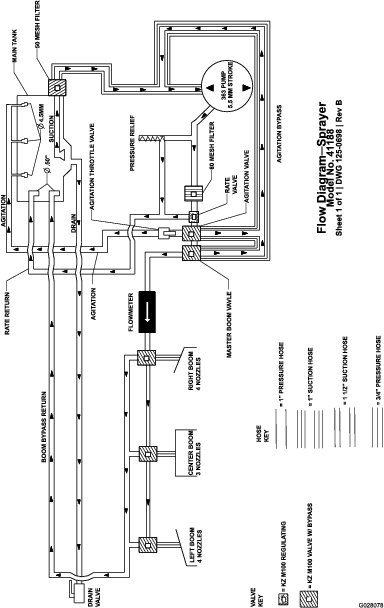| Maintenance Service Interval | Maintenance Procedure |
|---|---|
| Before each use or daily |
|
Introduction
This machine is a dedicated turf spray application machine and is intended to be used by professional, hired operators in commercial applications. It is designed primarily for spraying on well-maintained lawns in parks, golf courses, sports fields, and on commercial grounds.
It is intended for off-road use and not for extensive driving on public roads.
Read this information carefully to learn how to operate and maintain your product properly and to avoid injury and product damage. You are responsible for operating the product properly and safely.
You may contact Toro directly at www.Toro.com for product safety and operation training materials, accessory information, help finding a dealer, or to register your product.
Whenever you need service, genuine Toro parts, or additional information, contact an authorized Toro distributor or Toro Customer Service and have the model and serial numbers of your product ready. Figure 1 identifies the location of the model and serial numbers on the product. Write the numbers in the space provided.
Important: With your mobile device, you can scan the QR code on the serial number decal (if equipped) to access warranty, parts, and other product information.
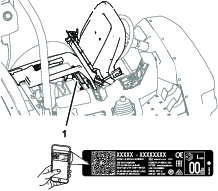
This manual identifies potential hazards and has safety messages identified by the safety-alert symbol (Figure 2), which signals a hazard that may cause serious injury or death if you do not follow the recommended precautions.

This manual uses 2 words to highlight information. Important calls attention to special mechanical information and Note emphasizes general information worthy of special attention.
This product complies with all relevant European directives; for details, please see the separate product specific Declaration of Conformity (DOC) sheet.
It is a violation of California Public Resource Code Section 4442 or 4443 to use or operate the engine on any forest-covered, brush-covered, or grass-covered land unless the engine is equipped with a spark arrester, as defined in Section 4442, maintained in effective working order or the engine is constructed, equipped, and maintained for the prevention of fire.
The enclosed engine owner's manual is supplied for information regarding the US Environmental Protection Agency (EPA) and the California Emission Control Regulation of emission systems, maintenance, and warranty. Replacements may be ordered through the engine manufacturer.
Warning
CALIFORNIA
Proposition 65 Warning
The engine exhaust from this product contains chemicals known to the State of California to cause cancer, birth defects, or other reproductive harm.
Battery posts, terminals, and related accessories contain lead and lead compounds, chemicals known to the State of California to cause cancer and reproductive harm. Wash hands after handling.
Use of this product may cause exposure to chemicals known to the State of California to cause cancer, birth defects, or other reproductive harm.
Safety
Improper use or maintenance by the operator or owner can result in injury. To reduce the potential for injury, comply with these safety instructions and always pay attention to the safety-alert symbol (Figure 2), which means Caution, Warning, or Danger—personal safety instruction. Failure to comply with instruction may result in personal injury or death.
This machine has been designed in accordance with the requirements of SAE J2258.
General Safety
This product is capable of causing personal injury. Always follow all safety instructions to avoid serious personal injury.
Using this product for purposes other than its intended use could prove dangerous to you and bystanders.
-
Read and understand the contents of this Operator’s Manual before starting the engine.
-
Use your full attention while operating the machine. Do not engage in any activity that causes distractions; otherwise, injury or property damage may occur.
-
Use appropriate personal protective equipment (PPE) to guard against contact with chemicals. Chemical substances used in the sprayer system may be hazardous and toxic.
-
Do not put your hands or feet near moving components of the machine.
-
Do not operate the machine without all guards and other safety protective devices in place and working on the machine.
-
Keep clear of any discharge area of the sprayer nozzles and spray drift. Keep bystanders and pets a safe distance away from the machine.
-
Keep children out of the operating area. Never allow children to operate the machine.
-
Stop the machine, shut off the engine, and remove the key before filling, emptying, servicing, or unclogging the machine.
Improperly using or maintaining this machine can result in injury. To reduce the potential for injury, comply with these safety instructions and always pay attention to the safety-alert symbol, which means Caution, Warning, or Danger—personal safety instruction. Failure to comply with these instructions may result in personal injury or death.
You can find additional safety information where needed throughout this manual.
Not all the attachments that adapt to this machine are covered in this manual. Refer to the operator’s manual provided with each attachment for additional safety instructions.
Safety and Instructional Decals
 |
Safety decals and instructions are easily visible to the operator and are located near any area of potential danger. Replace any decal that is damaged or missing. |


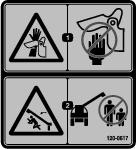

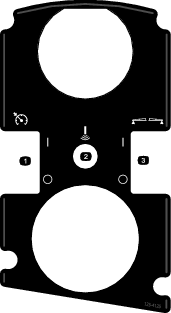
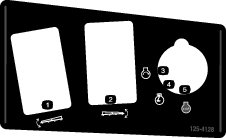
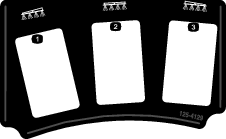


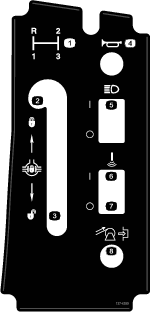
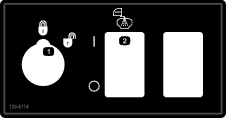
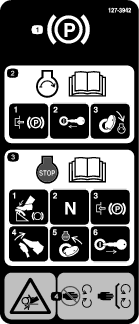


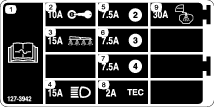

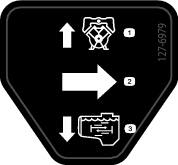

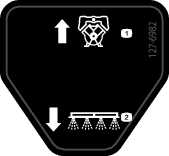
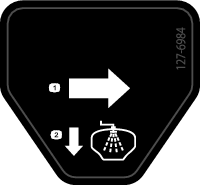
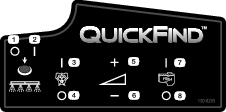
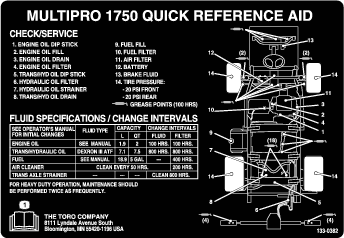
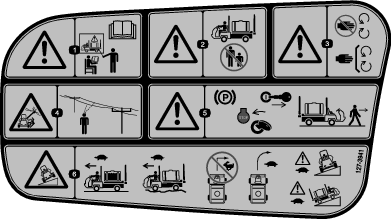
Setup
Note: Determine the left and right sides of the machine from the normal operating position.
Note: If you have questions or need additional information regarding the spray control system, refer to the Operator’s Manual supplied with the system.
Important: This sprayer is sold without spray nozzles.To use the sprayer, you must obtain and install the nozzles. Contact your authorized Toro distributor for information on the available section kit and accessories. After you install your nozzles and before using the sprayer for the first time, adjust the section bypass valves so that the pressure and application rate remains the same for all sections when you turn 1 or more sections off. Refer to Calibrating the Section-Bypass Valves.
Installing the Anti-Siphon Fill Receptacle
Parts needed for this procedure:
| 90° fitting | 1 |
| Quick coupler | 1 |
| Hose adapter | 1 |
| Fill-receptacle bracket | 1 |
| Flange-head bolt (5/16 x 3/4 inch) | 1 |
| Anti-siphon hose | 1 |
-
Place the fill-receptacle bracket over the threaded hole in the tank and secure it with a flange-head bolt (5/16 x 3/4 inch) as shown in Figure 3.
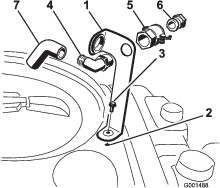
-
Place the threaded end of the 90° elbow fitting through the bracket and thread the quick coupler onto it, securing it to the bracket (Figure 3).
Note: Install the fitting with the open end pointing toward the large opening in the bracket and toward the tank opening so that the water arcs into the tank when you fill it.
-
Install the hose adapter into the quick coupler (Figure 3).
-
Lock the adapter into place by swinging the levers toward the adapter and then secure them with the hairpin cotters (Figure 3).
-
Install the anti-siphon hose through the large opening on the bracket and onto the barbed end of the 90° elbow fitting (Figure 3).
Important: Do not lengthen the hose to allow contact with the tank fluids.
Checking the Section-Hinge Springs
Important: Operating the spray system with the section-hinge springs under the incorrect compression could damage the boom assembly. Measure the springs and use the jam nut to compress the springs to 4 cm (1-1/2 inches) if necessary.
The sprayer is shipped with the section extensions swung forward to facilitate shipping the machine. The springs are not fully tightened at the time of manufacture to allow the sections to be in this position for transit. Before operating the machine, the springs must be adjusted to the correct compression.
-
If necessary, remove the packing components that secure the right and left extension sections during shipping.
-
Support the sections while they are extended to the spray position.
-
At the section hinge, measure the compression of the upper and lower springs while the sections are in their extended position (Figure 4).
-
All springs must be compressed until they measure 4 cm (1-1/2 inches).
-
Use the jam nut to compress any spring that measure greater than 4 cm (1-1/2 inches).
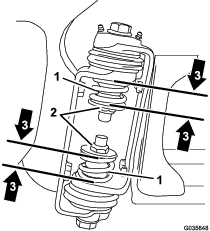
-
-
Repeat the procedure for each spring on both section hinges.
-
Move the sections into the transport ‘X’ position. See Positioning the Spray Sections for more information.
Product Overview
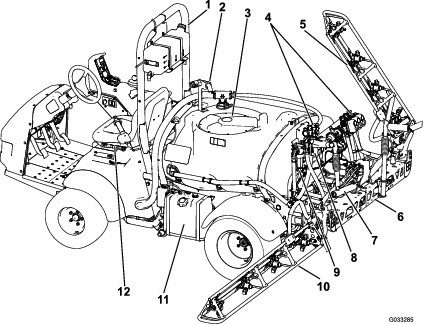
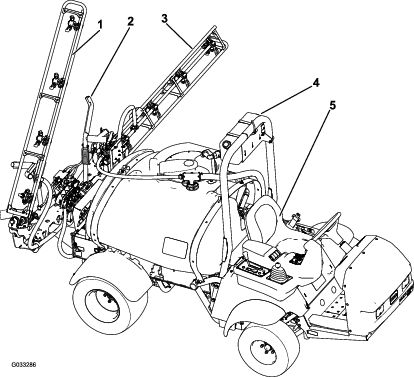
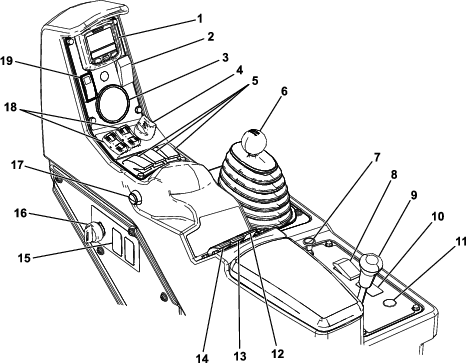
Accelerator Pedal
The accelerator pedal (Figure 8) gives you the ability to vary the ground speed of the sprayer. Pressing the pedal increases ground speed. Releasing the pedal slows the sprayer and reduces the engine speed to idle.
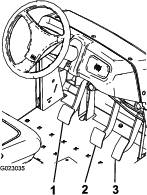
Clutch Pedal
Fully press the clutch pedal (Figure 8) to disengage the clutch when starting the engine or shifting transmission gears. Release the pedal smoothly when the transmission is in gear to prevent unnecessary wear on the transmission and other related parts.
Important: Do not ride the clutch pedal during operation. The clutch pedal must be fully out or the clutch will slip, causing heat and wear. Never hold the machine stopped on a hill using the clutch pedal. Damage to the clutch may occur.
Brake Pedal
Use the brake pedal to stop or slow the sprayer (Figure 8).
Caution
Brakes can become worn or can be adjusted incorrectly resulting in personal injury.
If brake pedal travels to within 2.5 cm (1 inch) of the sprayer floor board, adjust or repair the brakes.
Parking Brake
The parking brake is a large lever to the left of the seat (Figure 9). Engage the parking brake whenever you leave the seat to prevent accidental movement of the sprayer. To engage the parking brake, pull up and back on the lever. To disengage, push it forward and down. If the sprayer is parked on a steep grade, apply the parking brake and place blocks at the downhill side of the wheels.
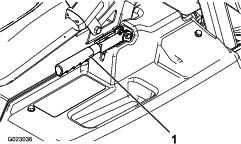
Hill Assist
Hill assist prevents the sprayer from rolling or jerking by temporarily holding the sprayer on hilly terrain when you move your foot from the brake pedal to the accelerator pedal. To engage hill assist, engage the clutch and push down on the brake pedal firmly. When hill assist is engaged, the hill assist icon appears on the InfoCenter; refer to the Multi Pro 1750 Turf Sprayer Software Guide. Hill assist holds the machine for 2 seconds after releasing the brake pedal.
Note: The hill assist only temporarily holds the machine: you cannot use it in place of the parking brake.
Differential Lock
The differential lock allows you to lock the rear axle for increased traction. You may engage the differential lock (Figure 7) while the sprayer is in motion. Move the lever forward and to the right to engage the lock.
Note: You may need to drive the machine forward while turning slightly to engage or disengage the differential lock.
Caution
Turning with the differential lock on can result in loss of machine control.
Do not operate with differential lock on when making sharp turns or at high speeds; refer to Using the Differential Lock.
Choke Control
The choke control is a small knob behind the range selector (Figure 7). To start a cold engine, pull the choke control up. After the engine starts, regulate the choke to keep the engine running smoothly. As soon as possible, push the control down to the OFF position. A warm engine requires little or no choking.
Range Selector
The range selector (Figure 7) has 5 positions: 3 forward speeds, NEUTRAL, and REVERSE. The engine starts only when the range selector is in the NEUTRAL position.
Ignition Switch
The ignition switch (Figure 7), has 3 positions: STOP, RUN, and START. Rotate the key clockwise to the START position to start the engine and release it to the RUN position when started. Rotate the key to the STOP position to shut off the engine.
Headlight Switch
Toggle the switch to operate the headlights (Figure 7). Push it forward to turn the lights on and rearward to turn them off.
Throttle/Speed-Lock Switch
When the range selector is in the NEUTRAL position, you can use the accelerator pedal to speed up the engine, then push the switch below the InfoCenter forward to set the engine at that speed. This is necessary to run the chemical agitation while stationary or operating attachments such as the hand sprayer (Figure 7).
Important: The range selector must be in the NEUTRAL position and the parking brake must be set for the switch to work.
Fuel Gauge
The fuel gauge is located on top of the fuel tank, on the left side of the machine, and shows the amount of fuel in the tank.
Master Section Switch
The master section switch (Figure 7) is located on the side of the console and to the right of the operator’s seat. It allows you to start or stop the spray operation. Press the switch to enable or disable the spray system.
Left, Center, and Right Section Switches
The left, center, and right section switches are located on the control panel (Figure 7). Toggle each switch forward to turn the corresponding section on and rearward to turn them off. When the switch is turned on, a light on the switch illuminates. These switches affect the spray system only when the master section switch is on.
Pump Switch
The pump switch is located on the control panel to the right of the seat (Figure 7). Toggle this switch forward to run the pump or rearward to stop the pump.
Important: The pump switch engages only when the engine is at low idle to avoid damaging the pump drive.
Application-Rate Switch
The application-rate switch is located on the control panel to the right of the seat (Figure 7). Press and hold the switch forward to increase the spray system pressure, or press and hold it rearward to decrease the pressure.
Supervisor (Rate-Lockout) Switch
The supervisor switch is located on the control panel to the right of the seat (Figure 7). Turn the key counterclockwise to the LOCK position to disable the application-rate switch, thereby keeping anyone from accidentally changing the application rate. Turn the key clockwise to the UNLOCKED position to enable the application-rate switch.
Boom-Section Lift Switches
The boom-section lift switches are located on the control panel and are used to raise the outer boom sections.
Hour Meter
The hour meter indicates the total number of hours the engine has run. This number is displayed on the first screen of the InfoCenter. The hour meter starts to function whenever the key is turned to the RUN position.
Foam-Marker Switch Locations (Optional)
If you install the Foam Marker kit, you will add switches to the control panel for controlling their operation. The sprayer comes with plastic plugs in these locations.
Regulating (Rate-Control) Valve
This valve, located behind the tank (Figure 10), controls the amount of fluid routed to the sections or the rate return to the tank.

Master-Section Valve
The master-section valve (Figure 10) controls the flow to the flow meter and section valves.
Flow meter
The flow meter measures the flow rate of the fluid for use by the InfoCenter system (Figure 10).
Section Bypass Valves
These valves turn the right, center, and left sections on or off (Figure 10).
Section-Bypass Shutoff Valve
The section bypass shutoff valve redirects the fluid flow for a section to the tank when you turn off the section. You can adjust the section bypass to ensure that the section pressure remains constant no matter how many sections are on. Refer to Adjusting the Section Bypass Valves.
Agitation Valve
This valve is located on the rear of the tank (Figure 10). When agitation is on, the flow is directed through the agitation nozzles in the tank. When agitation is off, the flow is directed through the pump suction.
Pressure Gauge
The pressure gauge is located on the control panel (Figure 7). This gauge shows the pressure of the fluid in the system in psi and kPa.
InfoCenter LCD Display
The InfoCenter LCD display shows information about your machine and battery pack, such as the current battery charge, the speed, diagnostics information, and more (Figure 7).
For more information, refer to the Multi Pro 1750 Software Guide.
Agitation-Throttle Valve
The agitation-throttle valve is used to reduce the flow available for the agitation circuit. It provides additional flow for the sections.
Note: Specifications and design are subject to change without notice.
| Weight with standard spray system, empty, without operator | 953 kg (2,100 lb) |
| Weight with standard spray system, full, without operator | 1678 kg (3,700 lb) |
| Maximum gross vehicle weight (GVW) (on level ground) | 1814 kg (4,000 lb) |
| Overall length with standard spray system | 343 cm (135 inches) |
| Overall height with standard spray system | 191 cm (75 inches) |
| Overall height with standard spray system to the top of the sections stored in the X position | 246 cm (97 inches) |
| Overall width with standard spray system sections stored in the ‘X’ position | 178 cm (70 inches) |
| Ground clearance | 14 cm (5.5 inches) |
| Wheel base | 155 cm (61 inches) |
| Tank capacity (includes the CE 5% overflow) | 662 L (175 US gallons) |
Attachments/Accessories
A selection of Toro approved attachments and accessories is available for use with the machine to enhance and expand its capabilities. Contact your authorized Toro distributor.
To ensure optimum performance and continued safety certification of the machine, use only genuine Toro replacement parts and accessories. Replacement parts and accessories made by other manufacturers could be dangerous, and such use could void the product warranty.
Operation
Note: Determine the left and right sides of the machine from the normal operating position.
Before Operation
Before Operation Safety
General Safety
-
Never allow children or untrained people to operate or service the machine. Local regulations may restrict the age of the operator. The owner is responsible for training all operators and mechanics.
-
Become familiar with the safe operation of the equipment, operator controls, and safety signs.
-
Know how to stop the machine and shut off the engine quickly.
-
Check that operator-presence controls, safety switches, and shields are attached and functioning properly. Do not operate the machine unless they are functioning properly.
-
If the machine does not function correctly or is damaged in any way, do not use the machine. Correct the problem before you operate the machine or attachment.
-
Ensure that the operator and passenger areas are clean and free from chemical residue and debris buildup.
-
Ensure that all fluid line connectors are tight and that all hoses are in good condition before applying pressure to the system.
Fuel Safety
-
Use extreme care in handling fuel. It is flammable and its vapors are explosive.
-
Extinguish all cigarettes, cigars, pipes, and other sources of ignition.
-
Use only an approved fuel container.
-
Do not remove the fuel cap or fill the fuel tank while the engine is running or hot.
-
Do not add or drain fuel in an enclosed space.
-
Do not store the machine or fuel container where there is an open flame, spark, or pilot light, such as on a water heater or other appliance.
-
If you spill fuel, do not attempt to start the engine; avoid creating any source of ignition until the fuel vapors have dissipated.
Chemical Safety
Chemical substances used in the sprayer system may be hazardous and toxic to you, bystanders, and animals, and they may damage plants, soil, and other property.
If you will use more than 1 chemical, read the information on each chemical. Refuse to operate or work on the sprayer if this information is not available.
Before working on a sprayer system, ensure that it has been neutralized and triple rinsed according to the recommendations of the chemical manufacturer(s) and that all the valves have been cycled 3 times.
Verify that there is an adequate supply of clean water and soap nearby, and immediately wash off any chemicals that contact you.
-
Carefully read and follow the chemical warning labels and material safety data sheets (MSDS) for all chemicals used, and protect yourself according to the chemical manufacturer's recommendations.
-
Always protect your body while using chemicals. Use the appropriate personal protective equipment (PPE) to guard against contact with chemicals, such as the following:
-
safety glasses, goggles, and/or face shield
-
a chemical suit
-
a respirator or filter mask
-
chemical-resistant gloves
-
rubber boots or other substantial footwear
-
a clean change of clothes, soap, and disposable towels for cleanup
-
-
Obtain proper training before using or handling chemicals.
-
Use the correct chemical for the job.
-
Follow the chemical manufacturer's instructions for the safely applying the chemical. Do not exceed the recommended system application pressure.
-
Do not fill, calibrate, or clean the machine while people, especially children, or pets are in the area.
-
Handle chemicals in a well-ventilated area.
-
Have clean water available, especially when filling the spray tank.
-
Do not eat, drink, or smoke while working near chemicals.
-
Do not clean spray nozzles by blowing through them or placing them in your mouth.
-
Always wash your hands and other exposed areas as soon as possible after working with chemicals.
-
Keep chemicals in their original packages and stored in a safe location.
-
Properly dispose of unused chemicals and chemical containers as instructed by the chemical manufacturer and your local codes.
-
Chemicals and fumes are dangerous; never enter the tank or place your head over or in the opening of a tank.
-
Follow all local, state, and federal regulations for spreading or spraying chemicals.
Performing Pre-Starting Checks
Check the following items each time you begin use of the sprayer for the day:
-
Check the air pressure in the tires.
Note: The tires of this machine are different than car tires; they require less air pressure in order to minimize turf compaction and damage.
-
Check all fluid levels and add the appropriate amount of specified fluids, if any are found to be low.
-
Check the brake pedal operation.
-
Check to see that the lights are working.
-
Turn the steering wheel to the left and right to check steering response.
-
With the engine shut off, check for oil leaks, loose parts, and any other noticeable malfunctions.
If any of the above items are not correct, notify your mechanic or check with your supervisor before taking the sprayer out for the day. Your supervisor may want you to check other items on a daily basis, so ask what inspections you are responsible to perform.
Preparing the Machine
Checking the Engine Oil
The engine is shipped with oil in the crankcase; however, the level of oil must be checked before you first start the engine and after you have run it.
-
Position the machine on a level surface.
-
Remove the dipstick and wipe it with a clean rag (Figure 11).
-
Insert the dipstick into the tube and make sure that it is seated fully. Remove the dipstick and check the oil level.

-
If the oil level is low, remove the filler cap from the valve cover (Figure 11) and pour oil into the opening until the oil level is up to the FULL mark on the dipstick; refer toServicing the Engine Oil for the proper oil type and viscosity.
Note: Add the oil slowly and check the level often during this process. Do not overfill.
-
Install the dipstick firmly in place.
Checking the Air Pressure in the Tire
Fill the tires with air to 138 kPa (20 psi). Also, check the tires for wear or damage.
Note: Replace any worn or damaged tires.
Adding Fuel
Fuel Specification
| Petroleum fuel | Use unleaded gasoline with an octane rating of 87 or higher ((R+M)/2 rating method). |
| Ethanol blended fuel | Use an unleaded-gasoline blend with up to 10% ethanol (gasohol) or 15% MTBE (methyl tertiary butyl ether) by volume is acceptable. Ethanol and MTBE are not the same. |
| Gasoline with 15% ethanol (E15) by volume is not approved for use. Never use gasoline that contains more than 10% ethanol by volume, such as E15 (contains 15% ethanol), E20 (contains 20% ethanol), or E85 (contains up to 85% ethanol). Using unapproved gasoline may cause performance problems and/or engine damage which may not be covered under warranty. |
Important: For best results, use only clean, fresh fuel (less than 30 days old).
-
Do not use gasoline containing methanol.
-
Do not store fuel either in the fuel tank or fuel containers over the winter unless you use a fuel stabilizer.
-
Do not add oil to gasoline.
Filling the Fuel Tank
The fuel tank capacity is approximately 19 L (5 US gallons).
Note: The fuel-tank cap contains a gauge that shows the fuel level; check it frequently.
-
Park the machine on a level surface, engage the parking brake, shut off the engine, and remove the key.
-
Clean the area around the fuel-tank cap (Figure 12).

-
Remove the fuel-tank cap.
-
Fill the tank to about 2.5 cm (1 inch) below the top of the tank (bottom of the filler neck).
Note: This air space in the tank allows fuel to expand. Do not overfill the tank.
-
Install the fuel-tank cap to the tank securely.
-
Wipe up any spilled fuel.
Breaking in a New Machine
| Maintenance Service Interval | Maintenance Procedure |
|---|---|
| After the first 100 hours |
|
-
Check the engine-oil and fluid levels regularly and be alert for indications of overheating in any component of the sprayer.
-
After starting a cold engine, let it warm up for about 15 seconds before accelerating.
-
To optimize the brake system, burnish (break in) the brakes as follows:
-
Load 454 L (120 US gallons) of water into the tank.
-
Move the machine to an open-level area.
-
Drive the machine at full speed.
-
Apply the brakes rapidly.
Note: Stop the machine in a straight line without locking up the tires.
-
Wait 1 minute to allow the brakes to cool.
-
Repeat steps 3 through 5 an additional 9 times.
-
-
Avoid racing the engine.
-
Vary the sprayer speed during operation. Avoid fast starts and quick stops.
-
Refer to for any special, low-hour checks.
Preparing the Sprayer
Selecting a Nozzle
Note: Refer to the nozzle-selection guide that is available through your authorized Toro distributor.
The turret bodies can accept up to 3 different nozzles. To select the desired nozzle, perform the following:
-
Stop the sprayer on a level surface, shut off the engine, and engage the parking brake.
-
Set the master section switch to the OFF position and set the spray-pump switch to the OFF position.
-
Rotate the turret of the nozzles in either direction to the correct nozzle.
-
Perform a flow calibration; refer to Calibrating the Sprayer Flow.
Selecting a Suction Filter
Standard Equipment: 50 mesh suction filter (blue)
Use the suction filter table to identify the screen mesh for the spray nozzles you are using based on chemicals products or solutions with a viscosity equivalent to water.
| Spray Nozzle Color Code (flow rate) | Screen Mesh Size* | Filter Color Code |
|---|---|---|
| Yellow (0.2 gpm) | 50 | Blue |
| Red (0.4 gpm) | 50 | Blue |
| Brown (0.5 gpm) | 50 (or 30) | Blue (or green) |
| Gray (0.6 gpm) | 30 | Green |
| White (0.8 gpm) | 30 | Green |
| Blue (1.0 gpm) | 30 | Green |
| Green (1.5 gpm) | 30 | Green |
| *The mesh size of the suction filters in this table are based on spray chemicals or solutions with the viscosity equivalent to water. | ||
Important: When you spray with higher viscosity (thicker) chemical products or solutions with wettable powders, you may need to use an coarser screen mesh for the optional suction filter; refer to Figure 13.
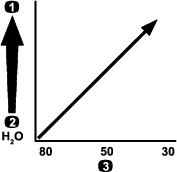
When you spray at a higher application rate, consider using a courser optional suction-filter mesh; refer to Figure 14.
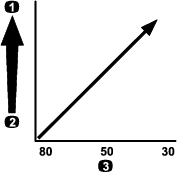
Selecting a Pressure Filter
Available screen sizes include:
Standard Equipment: 50 mesh suction filter (blue)
Use the pressure filter table to identify the screen mesh for the spray nozzles you are using based on chemicals products or solutions with a viscosity equivalent to water.
| Spray Nozzle Color Code (flow rate) | Screen Mesh Size* | Filter Color Code |
|---|---|---|
| As required for low viscosity chemicals or solutions or low application rates | 100 | Green |
| Yellow (0.2 gpm) | 80 | Yellow |
| Red (0.4 gpm) | 50 | Blue |
| Brown (0.5 gpm) | 50 | Blue |
| Gray (0.6 gpm) | 50 | Blue |
| White (0.8 gpm) | 50 | Blue |
| Blue (1.0 gpm) | 50 | Blue |
| Green (1.5 gpm) | 50 | Blue |
| As required for high viscosity chemicals or solutions or high application rates | 30 | Red |
| As required for high viscosity chemicals or solutions or high application rates | 16 | Brown |
| *The mesh size of the pressure filters in this table are based on spray chemicals or solutions with the viscosity equivalent to water. | ||
Important: When you spray with higher viscosity (thicker) chemical products or solutions with wettable powders, you may need to use a coarser screen mesh for the optional pressure-filter; refer to Figure 15.
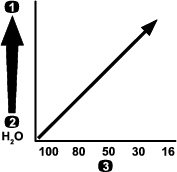
When you spray at a higher application rate, consider using an courser optional pressure-filter mesh; refer to Figure 16.
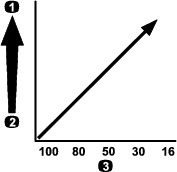
Selecting a Nozzle-Tip Filter (Optional)
Note: The use the optional nozzle-tip filter to protect the spray-nozzle tip and increase its service life.
Use the nozzle-tip filter table to identify the screen mesh for the spray nozzles you are using based on chemicals products or solutions with a viscosity equivalent to water.
| Spray Nozzle Color Code (flow rate) | Filter Mesh Size* | Filter Color Code |
|---|---|---|
| Yellow (0.2 gpm) | 100 | Green |
| Red (0.4 gpm) | 50 | Blue |
| Brown (0.5 gpm) | 50 | Blue |
| Gray (0.6 gpm) | 50 | Blue |
| White (0.8 gpm) | 50 | Blue |
| Blue (1.0 gpm) | 50 | Blue |
| Green (1.5 gpm) | 50 | Blue |
| *The mesh size of the nozzle filters in this table are based on spray chemicals or solutions with the viscosity equivalent to water. | ||
Important: When you spray with higher viscosity (thicker) chemical products or solutions with wettable powders, you may need to use a coarser screen mesh for the optional tip-filter; refer to Figure 17.
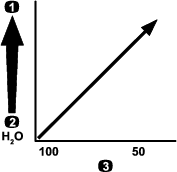
When you spray at a higher application rate, consider using an courser tip-filter mesh; refer to Figure 18.
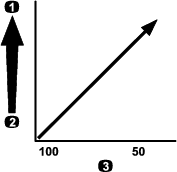
Filling the Tanks
Filling the Fresh-Water Tank
Important: Do not use reclaimed water (gray water) in the fresh-water tank.
Note: The fresh-water tank is used to supply a source of fresh water for you to wash chemicals off your skin, eyes, or other surfaces in the case of accidental exposure.
Always fill the fresh-water tank with clean water before handling or mixing any chemicals.
-
To fill the tank, unscrew the cap at the top of the tank, fill the tank with fresh water, and install the cap (Figure 19).
-
To open the fresh-water tank spigot, turn the lever on the spigot (Figure 19).

Filling the Spray Tank
Install the optional Chemical Pre-Mix Kit for optimal mixing and exterior tank cleanliness.
Important: Whenever possible, do not use reclaimed water (gray water) in the spray tank.
Important: Ensure that the chemicals you will be using are compatible for use with VitonTM (see the manufacturer's label; it should indicate if it is not compatible). Using a chemical that is not compatible with VitonTM will degrade the O-rings in the sprayer, causing leaks.
Important: Verify that the proper application rate has been set prior to filling the tank with chemicals.
-
Purge the spray system of spray-system conditioner by running the sections.
-
Stop the sprayer on a level surface, move the range selector to the NEUTRAL position, shut off the engine, and set the parking brake.
-
Ensure that the tank drain valve is closed.
-
Determine the amount of water needed to mix the amount of chemical you need as prescribed by the chemical manufacturer.
-
Open the tank cover on the spray tank.
Note: The tank cover is located in the center of the top of the tank. To open it, turn the front half of the cover counterclockwise and swing it open. You can remove the strainer inside for cleaning. To seal the tank, close the cover and rotate the front half clockwise.
-
Add 3/4 of the required water to the spray tank using the anti-siphon fill receptacle.
Important: Always use fresh clean water in the spray tank. Do not pour concentrate into an empty tank.
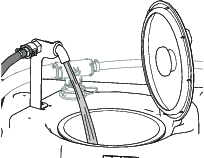
-
Start the engine and set the pump switch to the ON position.
-
Press the accelerator pedal to the floor and set the throttle lock to the ON position.
-
Set the master section switch to the OFF position.
-
Turn the agitation valve to the ON position.
-
Add the proper amount of chemical concentrate to the tank as directed by the chemical manufacturer.
Important: If you are using a wettable powder without full agitation, mix the powder with a small amount of water to form a slurry before adding it to the tank.
-
Add the remaining water to the tank.
Note: For better agitation, decrease the application rate setting.
Important: After filling the tank for the first time, check the tank straps for any play. Tighten as necessary.
Inspecting the Tank Straps
| Maintenance Service Interval | Maintenance Procedure |
|---|---|
| Before each use or daily |
|
Important: Overtightening the tank strap fasteners can result in deforming and damaging the tank and straps.
Important: Whenever possible, do not use reclaimed water (gray water) in the spray tank.
-
Fill the main tank with water.
-
Check to see if there is any movement between the tank straps and the tank (Figure 21).
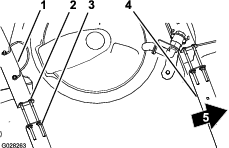
-
If the tank straps fit loose to the tank, tighten the flanged locknuts and bolts at the top of straps until the straps are flush with the surface of the tank (Figure 21).
Note: Do not overtighten the tank strap hardware.
Calibrating the Sprayer Flow
Before using the sprayer for the first time, if you change the nozzles, or as needed, calibrate the sprayer flow.
Operator supplied equipment: A stop watch capable of measuring ± 1/10 second and a container graduated in 50 ml (1 fl oz) increments.
Preparing the Machine
Important: Whenever possible, do not use reclaimed water (gray water) in the spray tank.
-
Fill the spray tank with clean water.
Note: Ensure that there is enough water in the tank to complete the calibration.
-
Set the parking brake and turn the engine on.
-
Set the pump switch to the ON position, and turn on the agitation.
-
Press down on the accelerator pedal until you reach the maximum engine speed, and toggle the throttle lock switch to the ON position.
Performing a Catch Test
-
Set all 3 section switches and the master-section switch to the ON position.
-
Turn the supervisor (rate-lockout) switch to the UNLOCK position.
-
Prepare to perform a catch test using the graduated container.
-
Start at 2.75 bar (40 psi) and use the application-rate switch to adjust the spray pressure so that the catch test yields the amounts listed in the table below.
Note: Repeat the test 3 times and use the average.
Nozzle Color Milliliters collected in 15 seconds Ounces collected in 15 seconds Yellow 189 6.4 Red 378 12.8 Brown 473 16.0 Gray 567 19.2 White 757 25.6 Blue 946 32.0 Green 1,419 48.0 -
Once the catch test has yielded the amounts listed in the table above, set the supervisor rate lockout switch to the LOCK position.
-
Turn off the master-section switch.
Performing the Sprayer Flow Calibration
-
On the InfoCenter, navigate to the Calibration menu and select FLOW CAL as follows:
Note: Selecting the Home Screen icon at any time cancels calibrations.
-
Press the center selection button on the InfoCenter twice to access the menus.
-
Enter the calibration menu by pressing the right selection button on the InfoCenter.
-
Select FLOW CAL by highlighting FLOW CAL and press the right selection button on the InfoCenter.
-
In the next screen, enter the known quantity of water that will be sprayed out of the sections for the calibration procedure; refer to the chart below.
-
Press the right selection button on the InfoCenter.
-
-
Using the plus (+) and minus (-) symbols, enter the flow volume according to the table below.
Nozzle Color Liters US Gallons Yellow 42 11 Red 83 22 Brown 106 28 Gray 125 33 White 167 44 Blue 208 55 Green 314 83 -
Turn on the master-section switch for 5 minutes.
Note: As the machine sprays, the InfoCenter displays the quantity of fluid that it is counting.
-
After spraying for 5 minutes, select the checkmark by pressing the center button on the InfoCenter.
Note: It is acceptable if the gallons displayed during the calibration process do not match the known quantity of water entered into the InfoCenter.
-
Shut off the master-section switch.
Note: Calibration is now complete.
Calibrating the Sprayer Speed
Before using the sprayer for the first time, if you change the nozzles, or as needed, calibrate the sprayer speed.
Important: Whenever possible, do not use reclaimed water (gray water) in the spray tank.
-
Fill the tank with clean water.
-
On an open, flat area, mark off a distance between 45 to 152 m (150 to 500 ft).
Note: Toro recommends marking off 152 m (500 ft) for more accurate results.
-
Start the engine and drive to the start of the marked-off distance.
Note: Align the center of the front tires with the starting line for the most accurate measurement.
-
On the InfoCenter, navigate to the Calibration menu and select SPEED CAL.
Note: Selecting the Home Screen icon at any time cancels calibrations.
-
Select the Next arrow (→) on the InfoCenter.
-
Using the plus (+) and minus (-) symbols, enter the marked-off distance into the InfoCenter.
-
Shift the machine into first gear and drive the marked distance in a straight line at full throttle.
-
Stop the machine at the marked-off distance and select the check mark on the InfoCenter.
Note: Slow down and roll to a stop to align the center of the front tires with the finish line, for the most accurate measurement.
Note: Calibration is now complete.
Calibrating the Section-Bypass Valves
Before using the sprayer for the first time, if you change the nozzles, or as needed, calibrate the sprayer section bypass
Important: Select an open flat area to perform this procedure.
Preparing the Machine
Important: Whenever possible, do not use reclaimed water (gray water) in the spray tank.
-
Fill the spray tank halfway with clean water.
-
Lower the sprayer sections.
-
Move the range selector to the NEUTRAL position and set the parking brake.
-
Set the 3 section switches to the ON position, but leave the master-section switch off.
-
Set the pump switch to the ON position, and turn on the agitation.
-
Press down on the accelerator pedal until you reach the maximum engine speed, and toggle the throttle lock switch to the ON position.
-
On the InfoCenter, navigate to the Calibration menu and select TEST SPEED.
Note: Selecting the Home Screen icon at any time cancels the calibration.
-
Using the plus (+) and minus (-) symbols, enter a test speed of 5.6 km/h (3.5 mph), then select the Home icon.
-
Turn the supervisor (rate-lockout) switch to the UNLOCK position, and turn the master-section switch to the ON position.
Adjusting the Section Bypass Valves
-
Using the application-rate switch, adjust the application rate according to the table below.
Nozzle Color SI (Metric) English Turf Yellow 159 L/ha 17 gpa 0.39 gpk Red 319 L/ha 34 gpa 0.78 gpk Brown 394 L/ha 42 gpa 0.96 gpk Gray 478 L/ha 51 gpa 1.17 gpk White 637 L/ha 68 gpa 1.56 gpk Blue 796 L/ha 85 gpa 1.95 gpk Green 1,190 L/ha 127 gpa 2.91 gpk -
Turn off the left section and adjust the section-bypass knob (Figure 22) until the pressure reading is at the previously adjusted level (typically 2.75 bar or 40 psi).
Note: The numbered indicators on the bypass knob and needle are for reference only.
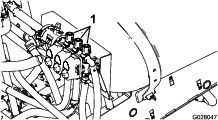
-
Turn on the left section and turn off the right section.
-
Adjust the right section-bypass knob (Figure 22) until the pressure reading is at the previously adjusted level (typically 2.75 bar or 40 psi).
-
Turn on the right section and turn off the center section.
-
Adjust the center section-bypass knob (Figure 22) until the pressure reading is at the previously adjusted level (typically 2.75 bar or 40 psi).
-
Turn each section off.
-
Turn the pump off.
Note: Calibration is now complete.
Adjusting the Agitation and Master Bypass Valves
Agitation-Bypass Valve Knob Position
-
The agitation-bypass valve is in the full open position as shown in Figure 23A.
-
The agitation-bypass valve is in the closed (0) position as shown in Figure 23B.
-
The agitation-bypass valve is in an intermediate (adjusted relative to the pressure gauge for the sprayer system) position as shown in Figure 23C.
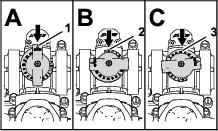
Calibrating the Agitation-Bypass Valve
| Maintenance Service Interval | Maintenance Procedure |
|---|---|
| Yearly |
|
Important: Whenever possible, do not use reclaimed water (gray water) in the spray tank.
Select an open flat area to perform this procedure.
-
Fill the spray tank with clean water.
-
Verify the agitation-control valve is open. If it has been adjusted, open it completely at this time.
-
Set the parking brake and start the engine.
-
Set the range selector to NEUTRAL.
-
Set the pump switch to the ON position.
-
Press the accelerator pedal to achieve maximum engine speed and set the throttle lock.
-
Set the 3 section valves to the OFF position.
-
Set the master-section switch to the ON position.
-
Set the system pressure to MAXIMUM.
-
Press the agitation switch to the OFF position and read the pressure gauge.
-
If the reading remains at 6.9 bar (100 psi) the agitation-bypass valve is properly calibrated.
-
If the pressure gauge reads differently, continue to the next step.
-
-
Adjust the agitation-bypass valve (Figure 24) on the backside of the agitation valve until the pressure reading on the gauge is 6.9 bar (100 psi).

-
Press the pump switch to the OFF position, shift the throttle lever to the IDLE position, and turn the ignition switch to the OFF position.
Adjusting the Master-Section-Bypass Valve
Important: Whenever possible, do not use reclaimed water (gray water) in the spray tank.
Note: Adjusting the master-section-bypass valve reduces or increases the amount of flow sent to the agitation nozzles in the tank when the master-section switch is set to the OFF position.
-
Fill the sprayer tank 1/2 full with clean water.
-
Move the machine to an open level surface.
-
Set the parking brake.
-
Set the range selector to the NEUTRAL position.
-
Set the pump switch to the ON position.
-
Set the agitation switch to the ON position.
-
Set the master-section switch to the OFF position.
-
Increase the engine speed to full throttle and set the throttle lock to the ON position.
-
Adjust the master-section-bypass handle to control the amount of agitation occurring in the tank (Figure 24).
-
Reduce the throttle speed to idle.
-
Set the agitation switch and pump switch to the OFF position.
-
Shut off the machine.
Locating the Spray Pump
The spray pump is located under the seat (Figure 25).

During Operation
During Operation Safety
General Safety
-
The owner/operator can prevent and is responsible for accidents that may cause personal injury or property damage.
-
Wear appropriate clothing, including eye protection; long pants; substantial, slip-resistant footwear; and hearing protection. Tie back long hair and do not wear loose jewelry.
-
Wear appropriate personal protective equipment as directed in .
-
Do not operate the machine while ill, tired, or under the influence of alcohol or drugs.
-
Do not carry passengers on the machine.
-
Operate the machine only in good visibility. Avoid holes or hidden hazards.
-
Before you start the engine, ensure that you are in the operating position, the transmission is in neutral, and the parking brake is engaged.
-
Remain seated whenever the machine is in motion. Keep both hands on the steering wheel whenever possible, and always keep your arms and legs within the operator’s compartment.
-
Use care when approaching blind corners, shrubs, trees, or other objects that may obscure your vision.
-
Before backing up, look rearward and ensure that no one is behind you. Back up slowly.
-
Never spray while people, especially children, or pets are nearby.
-
Do not spray near drop-offs, ditches, or embankments. The machine could suddenly roll over if a wheel goes over the edge or if the edge gives way.
-
Reduce the speed and load when operating on rough terrain, uneven ground, and near curbs, holes, and other sudden changes in terrain. Loads may shift, causing the machine to become unstable.
-
Sudden changes in terrain may cause abrupt steering wheel movement, possibly resulting in hand and arm injuries. Grip the steering wheel loosely around the perimeter, and keep your hands clear of the steering wheel spokes.
-
Stop the machine, shut off the engine, remove the key, engage the parking brake, and inspect for damage after striking an object or if there is an abnormal vibration in the machine. Make all necessary repairs before resuming operation.
-
Slow down and use caution when making turns and crossing roads and sidewalks with the machine. Always yield the right-of-way.
-
Use extra caution when operating the machine on wet surfaces, in adverse weather conditions, at higher speeds, or with a full load. Stopping time and distance increase in these conditions.
-
Do not touch the engine or muffler while the engine is running or soon after it has shut off. These areas may be hot enough to cause burns.
-
Before leaving the operator’s seat, do the following:
-
Stop the machine.
-
Shift the transmission into the NEUTRAL position (manual) or the PARK position (automatic).
-
Engage the parking brake.
-
Shut off the engine.
-
Remove the key.
-
-
Engine exhaust is fatal if inhaled. Do not run the engine indoors or in an enclosed area.
-
Never leave a running machine unattended.
-
Do not operate the machine when there is the risk of lightning.
-
Use accessories and attachments approved by The Toro® Company only.
ROPS Safety
Note: For each machine covered in this Operator’s Manual, a cab installed by Toro is a ROPS.
-
Do not remove the ROPS from the machine.
-
Fasten the seat belt and ensure that you can release it quickly in an emergency. Always wear your seat belt when the roll bar is up or on a machine with a cab installed by Toro.
-
Check carefully for overhead obstructions and do not contact them.
-
Keep the ROPS in safe operating condition by thoroughly inspecting it periodically for damage and keeping all the mounting fasteners tight.
-
Replace any damaged ROPS component. Do not repair or alter it.
Machines with a Foldable Roll Bar
-
Always use the seat belt with the roll bar in the raised position.
-
The ROPS is an integral safety device. Keep a folding roll bar in the raised and locked position, and use the seat belt when operating the machine with the roll bar in the raised position.
-
Lower a folding roll bar temporarily only when necessary. Do not wear the seat belt when the roll bar is folded down.
-
Be aware that there is no rollover protection when a folded roll bar is in the down position.
-
Check the area that you will be mowing and never fold down a folding roll bar in areas where there are slopes, drop-offs, or water.
Slope Safety
Slopes are a major factor related to loss of control and rollover accidents, which can result in severe injury or death. You are responsible for safe slope operation. Operating the machine on any slope requires extra caution.
-
Review the slope instructions listed below for operating the machine on slopes and to determine whether you can operate the machine in the conditions on that day and at that job site. Changes in the terrain can result in a change in slope operation for the machine.
-
Determine if the slope is safe for machine operation, including surveying the site. Always use common sense and good judgment when performing this survey.
-
Avoid starting, stopping, or turning the machine on slopes. Travel up and down on slopes. Avoid making sudden changes in speed or direction. If you must turn the machine, turn it slowly and gradually downhill, if possible. Use care when reversing the machine.
-
Do not operate a machine when you are uncertain about the traction, steering, or stability.
-
Remove or mark obstructions such as ditches, holes, ruts, bumps, rocks, or other hidden hazards. Tall grass can hide obstructions. Uneven terrain could overturn the machine.
-
Be aware that operating the machine on wet surfaces, across slopes, or downhill may cause the machine to lose traction. Loss of traction to the wheels may result in sliding and a loss of braking and steering.
-
Use extreme caution when operating the machine near drop-offs, ditches, embankments, water hazards, or other hazards. The machine could suddenly roll over if a wheel goes over the edge or the edge caves in. Establish a safety area between the machine and any hazard.
-
Use extra care while operating the machine with attachments; they can affect the stability of the machine.
-
If the engine stalls or you begin to lose momentum while climbing a hill, gradually apply the brakes and slowly back straight down the hill.
-
Always keep the transmission in gear (if applicable) when you drive the machine down a slope.
-
Do not park the machine on an incline.
-
The weight of the material in the tank can change the handling of the machine. To avoid loss of control and personal injury, follow these guidelines:
-
When operating with a heavy load, reduce your speed and allow for sufficient braking distance. Do not suddenly apply the brakes. Use extra caution on slopes.
-
Liquid loads shift, especially while turning, going up or down slopes, suddenly changing speeds, or while driving over rough surfaces. Shifting loads can cause the machine to tip over.
-
Operating the Machine
Starting the Engine
-
Sit in the operator's seat, insert the key into the ignition switch, and rotate the key clockwise to the RUN position.
-
Press the clutch and move the range selector to the NEUTRAL position.
-
Ensure that the pump switch is in the OFF position.
-
If the engine is cold, pull the choke knob up.
Important: Do not use the choke if the engine is warm.
-
Turn the key to the START position until the engine starts.
Important: Do not hold the key in the START position for more than 10 seconds. If the engine has not started after 10 seconds, wait 1 minute before trying again. Do not attempt to push or tow the sprayer to start the engine.
-
Once the engine starts, push the choke knob down slowly.
Driving the Machine
-
Release the parking brake.
-
Fully press the clutch pedal.
-
Move the gear shift lever to first gear.
-
Release the clutch pedal smoothly while pressing the accelerator pedal.
-
When the machine gains enough speed, remove your foot from the accelerator pedal, fully press the clutch pedal, move the gear shift lever to the next gear and release the clutch pedal while pressing the accelerator pedal. Repeat the procedure until the desired speed is attained.
Important: Always stop the machine before shifting from a forward gear to reverse or from reverse to a forward gear.
Note: Avoid long periods of engine idling.
Use the chart below to determine the ground speed of an empty machine at 3,400 rpm.
Gear Ratio Speed (km/h) Speed (mph) 1 66.4:1 5.6 3.5 2 38.1:1 9.8 6.1 3 19.6:1 19.2 11.9 R 80.7:1 4.7 2.9 Note: Leaving the ignition switch in the ON position for long periods of time without running the engine will discharge the battery.
Important: Do not attempt to push or tow the machine to get it started. Damage to the drive train could result.
Setting the Throttle Lock
Note: You must have the parking brake and spray pump on and the range selector in the NEUTRAL position to set the throttle lock.
-
Press down on the accelerator pedal to obtain the desired engine speed (rpm).
-
Toggle the throttle lock switch on the control panel to the ON position.
-
To release the throttle lock, toggle the switch to the OFF position, or press the brake or clutch pedal.
Setting the Speed Lock
Note: Before setting the speed lock, you must sit in the operator’s seat with the parking brake off, the pump on, and the range selector in gear.
-
Press down on the accelerator pedal to obtain the desired engine speed.
-
Toggle the speed lock switch on the control panel to the ON position.
-
To release the speed lock, toggle the switch to the OFF position, or press the brake or clutch pedal.
Shutting Off the Engine
-
Press the clutch and apply the brake to stop the sprayer.
-
Pull the parking-brake lever up and back to set it.
-
Move the range selector out of gear into the NEUTRAL position.
-
Turn the ignition key to the STOP position.
-
Remove the key from the switch to prevent accidental starting.
Using the Differential Lock
The differential lock increases the traction of the sprayer by locking the rear wheels so that 1 wheel does not spin out. This can help when you have heavy loads to haul on wet turf or slippery areas, going up hills, and on sandy surfaces. It is important to remember, however, that this extra traction is intended for temporary or limited use. Its use does not replace the safe operation, already discussed concerning steep hills and heavy loads.
The differential lock causes the rear wheels to turn at the same speed. When using differential lock your ability to make sharp turns is somewhat restricted and the tires may scuff the turf. Use the differential lock only when needed, at slower speeds and only in first or second gear.
Warning
Tipping or rolling the sprayer on a hill will cause serious injury.
-
The extra traction available with the differential lock can be enough to get you into dangerous situations, such as climbing slopes that are too steep to turn around. Be extra careful when operating with the differential lock on, especially on steeper slopes.
-
If the differential lock is on when making a sharp turn at a higher speed and the inside rear wheel lifts off the ground, there may be a loss of control which could cause the sprayer to skid. Use the differential lock only at slower speeds.
Operating the Sprayer
To operate the Multi Pro Sprayer, first fill the spray tank, then apply the solution to the work area, and finally clean the tank. Complete all 3 of these steps in sequence to avoid damaging the sprayer. For example, do not mix and add chemicals in the spray tank at night and then spray in the morning. This would lead to separation of the chemicals and to possible damage to the sprayer components.
Caution
Chemicals are hazardous and can cause personal injury.
-
Read the directions on the chemical labels before handling the chemicals, and follow all manufacturer recommendations and precautions.
-
Keep chemicals away from your skin. Should contact occur, wash the affected area thoroughly with soap and clean water.
-
Wear goggles and any other protective equipment recommended by the chemical manufacturer.
The Multi Pro Sprayer has been specifically designed to have high durability in order to give it the long sprayer life you need. Different materials have been chosen for specific reasons at different locations on your sprayer to meet this goal. Unfortunately, there is no single material which is perfect for all foreseeable applications.
Some chemicals are more aggressive than others, and each chemical interacts differently with various materials. Some consistencies (e.g., wettable powders, charcoal) are more abrasive and lead to higher-than-normal wear rates. If a chemical is available in a formulation that would provide increased life to the sprayer, use this alternative formulation.
As always, remember to clean your sprayer thoroughly after all applications. This will do the most to ensure that your sprayer has a long and trouble-free life.
Spraying
Important: To ensure that your solution remains well mixed, use the agitation feature whenever you have a solution in the tank. For agitation to work, you must have the pump on and the engine running above an idle. If you stop the machine and need agitation, set the parking brake, turn the pump on, press the accelerator pedal to floor, and switch the throttle lock to the ON position.
-
Lower the sections into position.
-
Set the spray-pump switch to the ON position.
-
Set the master-section switch in the OFF position, set the 3 section switches to the ON position.
-
Drive to the location where you will be spraying.
-
Set the master-section switch to the ON position to begin spraying.
Note: The InfoCenter shows the sections with the spray on.
Note: When the tank is nearly empty, the agitation may cause foaming in the tank. To prevent this, turn the agitation valve off. Alternatively, you can use an anti-foaming agent in the tank.
-
Use the rate switch to adjust and set a target.
-
When finished spraying, set the master-section switch to the OFF position to turn off all sections, then set the pump switch to the OFF position.
Positioning the Spray Sections
The boom-section lift switches on the sprayer control panel allows you to move the outer spray sections between transport position and spray position without leaving the operator's seat. Whenever possible, stop the machine before changing spray section positions.
Lowering the Outer-Spray Sections to the Spray Position
-
Park the machine on a level surface.
-
Use the boom-section lift switches to lower the outer sections.
Note: Wait until the outer spray sections reach the full, extended spray position.
Raising the Outer-Spray Sections to the Transport Position
-
Park the machine on a level surface.
-
Use the boom-section lift switches to raise the outer spray sections, until they have moved completely into boom-section transport cradles forming the “X” transport position, and the lift cylinders are fully retracted.
Important: Release the boom-section lift switch(es) once the outer spray sections have reached the desired position. Running the actuators against the mechanical stops may damage the lift cylinders and/or other hydraulic components.
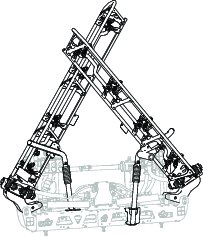
Important: To prevent damage to the lift cylinder, make sure that the actuators are fully retracted before transporting the machine.
Using the Boom-Section Transport Cradle
The sprayer is equipped with boom-section transport cradles that have a unique safety feature. In the event the spray section accidentally contacts with a low overhead object while in the transport position, you can push the spray section(s) out of the transport cradles. If this occurs, the spray sections come to rest in a near horizontal position to the rear of the machine. While this movement will not damage the spray sections, they should be immediately positioned into the transport cradle.
Important: The spray sections can be damaged by transporting them in any position other than the “X” transport position using the boom transport cradle.
To put the outer spray sections back into the transport cradle, lower the spray section(s) to the spray position and then raise the spray section(s) back to the transport position. Make sure that the lift cylinders are fully retracted to prevent damaging the actuator rod.
Spraying Tips
-
Do not overlap areas that you have previously sprayed.
-
Watch for plugged nozzles. Replace all worn or damaged nozzles.
-
Use the master section switch to stop the spray flow before stopping the sprayer. Once it stops, use the engine-throttle control to hold the engine speed up to keep the agitation running.
-
You will obtain better results if the sprayer is moving when you turn the spray sections on.
Unclogging a Nozzle
If a nozzle becomes clogged while you are spraying, clean the nozzle as follows:
-
Stop the sprayer on a level surface, shut off the engine, and engage the parking brake.
-
Set the master section switch to the OFF position and then set the sprayer-pump switch to the OFF position.
-
Remove the clogged nozzle and clean it using a spray bottle of water and a toothbrush.
-
Install the nozzle.
After Operation
After Operation Safety
-
After you finish operating the machine for the day, wash off all chemical residue from the outside of the machine; refer to Chemical Safety.
-
Allow the engine to cool before storing the machine in any enclosure.
-
Never store the machine or fuel container where there is an open flame, spark, or pilot light, such as on a water heater or other appliance.
-
Keep all parts of the machine in good working condition and all hardware tightened.
-
Replace all worn, damaged, or missing decals.
Cleaning the Sprayer
Cleaning the Sprayer System
Draining the Tank
-
Stop the sprayer, engage the parking brake, shut off the engine, and remove the key.
-
Locate the tank-drain valve at the left side of the machine, forward of the fuel tank (Figure 27).
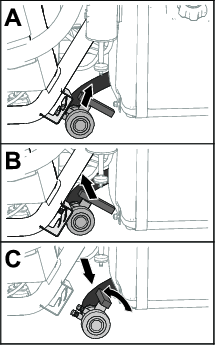
-
Lift the valve and move the it inboard until the mount studs of the valve clear the slots in the drain-valve bracket, and move the valve rearward (Figure 27).
-
Align the end of the valve with the drain container and rotate valve handle counterclockwise to the open position (Figure 27).
-
When the tank has drained completely, rotate the drain-valve handle to the closed position and assemble the valve onto the drain-valve bracket (Figure 27).
Important: Dispose of the sprayer tank chemicals according to local codes and the material manufacturer's instructions.
Cleaning Internal Sprayer Components
| Maintenance Service Interval | Maintenance Procedure |
|---|---|
| After each use |
|
Important: Use only clean water when cleaning the sprayer.
Important: You must always drain and flush out the sprayer, including any installed spray system accessories immediately after each use. Failure to flush and clean the sprayer may allow the chemicals to dry and obstruct in the lines, filters, valves, nozzle bodies, pump, and other components.
Use the approved Clean Rinse Kit for this machine. Contact your authorized Toro distributor for more information.
Note: The recommendations and instructions that follow assume that the Toro Rinse Kit is not installed.
Clean the spray system and any installed spray accessories after each spraying session. To properly clean the spray system, you must rinse it 3 times.
-
Fill the tank with at least 190 L (50 US gallons) of clean water and close the cover.
-
For the first and second times that you rinse the system, you can use a cleaning/neutralizing agent in the water as needed.
Note: On the final rinse, use only clean, clear water.
-
Lower the outer spray sections into the spray position.
-
Start the engine, set the spray pump switch to the ON position, and move the accelerator pedal to a higher engine speed.
-
Set the agitation switch to the ON position.
-
Use the application-rate switch to increase the pressure to a high setting.
-
Set the individual section switches and master section switch to the ON positions.
-
Check the nozzles to ensure that they are all spraying correctly.
-
Allow all of the water in the tank to spray out through the nozzles.
-
Set the master section switch to the OFF position, the set the agitation switch and spray-pump switch to the OFF position, and shut off the engine.
-
Repeat steps 1 through 10 at least 2 more times to ensure that the spray system is fully cleaned.
Important: You must always complete 3 rinse cycles to ensure that the spray system and spray accessories are fully clean, preventing damage to the system.
Cleaning External Sprayer Components
-
Clean the suction and pressure filters; refer to Cleaning the Suction Filter and Cleaning the Pressure Filter.
Important: If you used wettable powder chemicals, clean the strainer after each tank.
-
Using a garden hose, rinse off the outside of the sprayer with clean water.
-
Remove the nozzles and clean them by hand.
Note: Replace damaged or worn nozzles.
Note: If your machine has optional nozzle filters, clean them before installing the nozzles; refer to Cleaning the Optional Nozzle Filters.
Cleaning the Suction Filter
| Maintenance Service Interval | Maintenance Procedure |
|---|---|
| After each use |
|
-
Park the machine on a level surface, engage the parking brake, shut off the pump, shut off the engine, and remove the key.
-
At the top of the sprayer tank, remove the retainer that secures the hose fitting attached to the large hose from the filter housing (Figure 28).

-
Remove the hose and hose fitting from the filter housing (Figure 28).
-
Pull the suction strainer out of the filter housing in the tank (Figure 29).
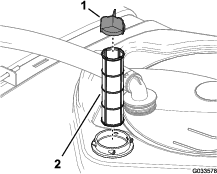
-
Clean the suction filter with clean water.
Important: Replace the filter if it is damaged or cannot be cleaned.
-
Insert the suction filter into the filter housing until the filter is fully seated.
-
Align the hose and hose fitting to the filter housing at the top of the tank, and secure fitting and housing with the retainer that you removed in step 2.
Cleaning the Pressure Filter
| Maintenance Service Interval | Maintenance Procedure |
|---|---|
| After each use |
|
-
Park the machine on a level surface, engage the parking brake, shut off the sprayer pump, shut off the engine, and remove the key.
-
Align a drain pan under the pressure filter (Figure 30).
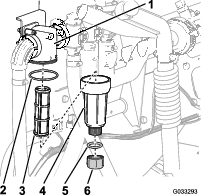
-
Rotate the drain cap counterclockwise and remove it from the bowl of the pressure filter (Figure 30).
Note: Allow the bowl to drain completely.
-
Rotate the bowl counterclockwise and remove the filter head (Figure 30).
-
Remove the pressure filter element (Figure 30).
-
Clean the pressure filter element with clean water.
Important: Replace the filter if it is damaged or cannot be cleaned.
-
Check the gasket for the drain plug (located inside the bowl) and the gasket for bowl (located inside the filter head) for damage and wear (Figure 30).
Important: Replace any damaged or worn gaskets for the plug, bowl, or both.
-
Install the pressure filter element into the filter head (Figure 30).
Note: Ensure that the filter element is firmly seated into the filter head.
-
Install the bowl onto the filter head, and tighten by hand (Figure 30).
-
Assemble the drain cap onto the fitting at the bottom of the bowl, and tighten the cap by hand (Figure 30).
Cleaning the Optional Nozzle Filters
-
Park the machine on a level surface, engage the parking brake, shut off the sprayer pump, shut off the engine, and remove the key.
-
Remove the nozzle from the spray turret (Figure 31).
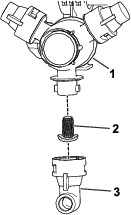
-
Remove the nozzle filter (Figure 31).
-
Clean the nozzle filter with clean water.
Important: Replace the filter if it is damaged or cannot be cleaned.
-
Install the nozzle filter (Figure 31).
Note: Ensure that the filter is fully seated.
-
Install the nozzle onto the spray turret (Figure 31).
-
Repeat steps 2 through 6 for the other spray nozzles.
Cleaning the Nozzle Body and Check-Valve Diaphragm
| Maintenance Service Interval | Maintenance Procedure |
|---|---|
| Yearly |
|
-
Rotate the diaphragm cap counterclockwise and remove the cap from the nozzle body (Figure 32).
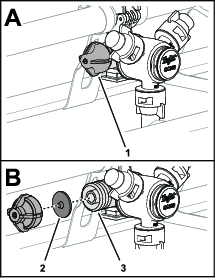
-
Remove the check-valve diaphragm from the cap or nozzle body (Figure 32).
-
Clean the cap, diaphragm, and nozzle body with clean water (Figure 32).
-
Assemble the diaphragm into the cap with the nib of the diaphragm toward the cap (Figure 32).
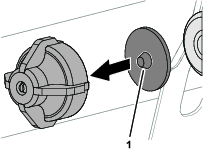
-
Assemble the cap and diaphragm to the nozzle body and tighten by hand (Figure 32).
-
Repeat steps 1 through 5 for the other spray nozzles.
Conditioning the Spray System
| Maintenance Service Interval | Maintenance Procedure |
|---|---|
| After each use |
|
Conditioner Specification
Conditioner specification: propylene glycol "non-toxic RV antifreeze” with corrosion inhibitor
Important: Use only propylene glycol with corrosion inhibitor. Do not use recycled propylene glycol. Do not use ethylene glycol base antifreeze.Do not use propylene glycol with soluble alcohols (methanol, ethanol or isopropanol) or brines added.
Preparing the Conditioner
-
Move the machine to a level surface, set the parking brake, shut off the engine, and remove the key.
-
Add conditioner to the tank as follows:
-
For ready to use (premixed) propylene glycol RV antifreeze—add 10 gallons of propylene glycol RV antifreeze to the tank.
-
For concentrated propylene glycol RV antifreeze, perform the following steps:
-
Add a 10 gallon mixture of propylene glycol RV antifreeze and water into the sprayer tank. Prepared the antifreeze mixture as instructed manufacturer for a concentration rated for -45°C (-50°F) minimum.
Important: Use only clean water when cleaning the sprayer.
-
Start the engine and set the spray-pump switch to the ON position.
-
Press the accelerator pedal to increase the engine speed.
-
Set the agitation switch to the ON position.
Allow the conditioner and water solution to circulate for 3 minutes or longer.
-
-
Spraying the Conditioner
Recommended tool: a clear catch container.
-
Move the machine to the drain pad area and set the parking brake.
-
Lower the outer booms sections.
-
Set the left, center, and right section switches and the master section switch to the ON position.
-
Allow the spray system to spray until the nozzles discharge the conditioner.
Note: Most propylene glycol RV antifreeze is colored pink. Use the catch container to sample the sprayer discharge at several of the nozzles.
-
Shut off the master section switch, 3 section switches, agitation switch, spray-pump switch, and engine.
Transporting the Sprayer
Use a trailer or truck when moving the machine long distances.
-
Use full-width ramps for loading the machine onto a trailer or truck.
-
Tie outer spray sections to the boom-section transport cradles.
-
Bind the machine securely to the transport vehicle; Figure 34 illustrates the tie-down loops of the machine.
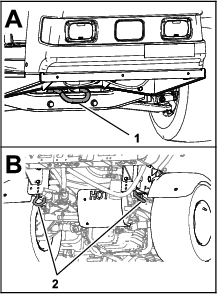
Towing the Sprayer
In case of an emergency, you can tow the sprayer for a short distance. However, do not use this as a standard procedure.
Warning
Towing at excessive speeds could cause a loss of steering control, resulting in personal injury.
Never tow the sprayer faster than 8 km/h (5 mph).
Towing the sprayer is a 2-person job. If you must move the machine a considerable distance, transport it on a truck or trailer; refer to Transporting the Sprayer.
-
Attach a tow line to the frame.
-
Put the range selector in the NEUTRAL position and release the parking brake.
-
Tow the sprayer at less than 8 km/h (5 mph).
Maintenance
Note: Download a free copy of the schematic by visiting www.Toro.com and searching for your machine from the Manuals link on the home page.For additional information about the sprayer system, refer to the sprayer system schematic in .
Note: Determine the left and right sides of the machine from the normal operating position.
Maintenance Safety
-
Allow only qualified and authorized personnel to maintain, repair, adjust, or inspect the machine.
-
Before performing any maintenance, thoroughly clean and rinse the sprayer.
-
Chemicals used in the sprayer system may be hazardous and toxic to you, bystanders, animals, plants, soils, or other property.
-
Carefully read and follow the chemical warning labels and material safety data sheets (MSDS) for all chemicals used, and protect yourself according to the chemical manufacturer’s recommendations.
-
Always protect your skin while you are near chemicals. Use the appropriate personal protective equipment (PPE) to guard against contact with chemicals, including the following:
-
safety glasses, goggles, and/or face shield
-
a chemical suit
-
a respirator or filter mask
-
chemical-resistant gloves
-
rubber boots or other substantial footwear
-
a clean change of clothes, soap, and disposable towels for cleanup
-
-
Refuse to operate or work on the sprayer if chemical safety information is not available.
-
Do not fill, calibrate, or clean the machine while people, especially children, or pets are in the area.
-
Handle chemicals in a well-ventilated area.
-
Have clean water available, especially when filling the spray tank.
-
Do not eat, drink, or smoke while working near chemicals.
-
Do not clean spray nozzles by blowing through them or placing them in your mouth.
-
Always wash your hands and other exposed areas as soon as possible after working with chemicals.
-
Chemicals and fumes are dangerous; never enter the tank or place your head over or in the opening of a tank.
-
-
Before servicing or adjusting the machine, park it on a level surface, engage the parking brake, shut off the engine, and remove the key, and allow the engine to cool.
-
To ensure that the entire machine is in good condition, keep all nuts, bolts, and screws properly tightened.
-
To reduce the potential for fire, keep the engine area free of excessive grease, chemicals, grass, leaves, and dirt.
-
If you must run the engine to perform a maintenance adjustment, keep your hands, feet, clothing, and any parts of your body away from the engine and any moving parts. Keep everyone away.
-
Do not adjust the ground speed of the machine. To ensure safety and accuracy, have an authorized Toro distributor check the ground speed.
-
If the machine requires a major repair or you need technical help, contact an authorized Toro distributor.
-
To ensure optimum performance and safety, always purchase genuine Toro replacement parts and accessories. Replacement parts and accessories made by other manufacturers could be dangerous.
-
Modifying this machine in any manner may affect machine operation, performance, durability, or its use, and result in injury or death. Such use could void the product warranty.
-
If possible, do not perform maintenance while the engine is running. Keep away from moving parts.
-
Use jack stands to support the machine or components when required.
-
Carefully release pressure from components with stored energy.
Recommended Maintenance Schedule(s)
| Maintenance Service Interval | Maintenance Procedure |
|---|---|
| After the first 8 hours |
|
| After the first 50 hours |
|
| After the first 100 hours |
|
| Before each use or daily |
|
| After each use |
|
| Every 50 hours |
|
| Every 100 hours |
|
| Every 200 hours |
|
| Every 400 hours |
|
| Every 800 hours |
|
| Yearly |
|
Important: Refer to the engine owner’s manual for additional maintenance procedures.
Notation for Areas of Concern
| Inspection performed by: | ||
| Item | Date | Information |
| 1 | ||
| 2 | ||
| 3 | ||
| 4 | ||
| 5 | ||
| 6 | ||
| 7 | ||
| 8 | ||
| 9 | ||
| 10 | ||
| 11 | ||
| 12 | ||
Caution
If you leave the key in the ignition switch, someone could accidently start the engine and seriously injure you or other bystanders.
Remove the key from the ignition and disconnect the wire(s) from the spark plug(s) before you perform any maintenance. Set the wire(s) aside so that it does not accidentally contact the spark plug(s).
Pre-Maintenance Procedures
Raising the Sprayer
Whenever the engine is run for routine maintenance and/or engine diagnostics, the rear wheels of the sprayer should be 2.5 cm (1 inch) off the ground with the rear axle supported on jack stands.
Danger
A sprayer on a jack may be unstable and slip off the jack, injuring anyone beneath it.
-
Do not start the engine while the sprayer is on a jack.
-
Always remove the key from the ignition before getting off the sprayer.
-
Block the tires when the sprayer is on a jack.
The jacking point at the front of the sprayer is under the front crossbar (Figure 35A). The jacking point at the rear of the sprayer is on the rear frame support, behind the rear tie-down loops (Figure 35B).

Lubrication
Greasing the Machine
| Maintenance Service Interval | Maintenance Procedure |
|---|---|
| Every 100 hours |
|
Grease Type: No. 2 lithium grease
Refer Figure 36 for the grease-point locations.
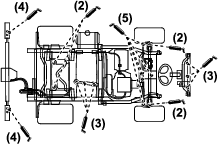
-
Wipe the grease fitting clean so that you do not force dirt or debris into the bearing or bushing.
-
Pump grease into the bearing or bushing.
-
Wipe off the excess grease.
Greasing the Sprayer Pump
| Maintenance Service Interval | Maintenance Procedure |
|---|---|
| Every 50 hours |
|
Grease Type: Mobil XHP 461
-
Raise the sprayer; refer to Raising the Sprayer.
-
Locate the sprayer pump.
Note: The pump is located below the seat; refer to Locating the Spray Pump.
-
Wipe the 2 remote grease fittings clean (Figure 37A and Figure 37B).
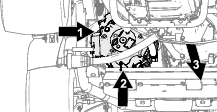
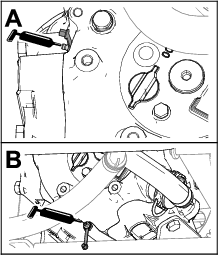
-
Pump grease into each remote grease fitting (Figure 37A and Figure 37B).
-
Wipe off the excess grease.
Greasing the Section Hinges
| Maintenance Service Interval | Maintenance Procedure |
|---|---|
| Every 100 hours |
|
Important: If the section hinge is washed with water, clear all water and debris from the hinge assembly and apply fresh grease.
Grease Type: No. 2 lithium grease
-
Wipe the grease fittings clean so that foreign matter cannot be forced into the bearing or bushing.
-
Pump grease into the bearing or bushing at each fitting (Figure 38).
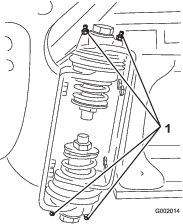
-
Wipe off excess grease.
-
Repeat the procedure for each section pivot.
Engine Maintenance
Engine Safety
Shut off the engine before checking the oil or adding oil to the crankcase.
Checking the Air-Intake Screen
| Maintenance Service Interval | Maintenance Procedure |
|---|---|
| Before each use or daily |
|
| Every 100 hours |
|
Check and clean as necessary the air-intake screen on the front of the engine before each use or daily.
Servicing the Air Cleaner
| Maintenance Service Interval | Maintenance Procedure |
|---|---|
| Every 50 hours |
|
| Every 200 hours |
|
Removing the Foam and Paper Elements
-
Set the parking brake, stop the pump, shut off the engine, and remove the ignition key.
-
Release the latch on the back of the seat and lift the seat forward.
-
Clean around the air cleaner to prevent dirt from getting into the engine and causing damage (Figure 39).
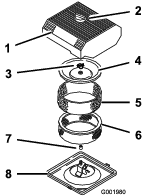
-
Loosen the knob on the air-cleaner cover and remove the cover (Figure 39).
-
Carefully slide the foam element off the paper element (Figure 39).
-
Unscrew the cover nut and remove the cover and paper element (Figure 39).
Cleaning the Foam Element
-
Wash the foam element in liquid soap and warm water.
-
When the element is clean, rinse it thoroughly.
-
Dry the element by squeezing it in a clean cloth.
-
Put 30 to 59 ml (1 to 2 fl oz) of oil on the element (Figure 40).
Important: Replace the foam element if it is torn or worn.

-
Squeeze the element to distribute the oil.
Checking the Paper Element
Inspect the paper element for tears, an oily film, damage to the rubber seal, excessive dirt, or other damage (Figure 41). If any of these conditions exist, replace the filter.
Important: Do not clean the paper element with pressurized air or liquids, such as a solvent, gasoline, or kerosene.
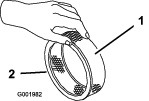
Important: To prevent engine damage, always operate the engine with the complete foam and paper air-cleaner assembly installed.
Installing the Foam and Paper Elements
-
Carefully slide the foam element onto the paper air-cleaner element (Figure 39).
-
Slide the air-cleaner assembly and cover onto the long rod.
-
Install the cover nut finger-tight against the cover (Figure 39).
Note: Ensure that the rubber seal is flat against the air-cleaner base and cover.
-
Install the air-cleaner cover and knob (Figure 39).
-
Close and latch the seat.
Servicing the Engine Oil
Crankcase Capacity is 2.0 L (2.1 US qt) with the filter.
Use high-quality engine oil that meets the following specifications:
-
API classification Level required: SJ or higher.
-
Preferred oil: SAE 10W30 (above 0°F)
-
Alternate oil: SAE 5W30 (below 32°F)
Toro Premium Engine Oil is available from your distributor in either 10W30 or 5W30 viscosity. See the Parts Catalog for part numbers.
Checking the Engine Oil
| Maintenance Service Interval | Maintenance Procedure |
|---|---|
| Before each use or daily |
|
| Every 400 hours |
|
The engine is shipped with oil in the crankcase; however, you must check the level of oil before you first start the engine and after you have run it.
-
Position the machine on a level surface.
-
Remove the dipstick and wipe it with a clean rag (Figure 42). Insert the dipstick into the tube and make sure that it is seated fully. Remove the dipstick and check the oil level.

-
If the oil level is low, remove the filler cap from the valve cover (Figure 42) and pour oil into the opening until the oil level is up to the FULL mark on the dipstick. Add the oil slowly and check the level often during this process. Do not overfill.
-
Install the dipstick firmly in place.
Changing the Engine Oil
| Maintenance Service Interval | Maintenance Procedure |
|---|---|
| After the first 50 hours |
|
| Every 100 hours |
|
-
Start the engine and let it run for 5 minutes. This warms the oil so it drains better.
-
Position the machine on a level surface, engage the parking brake, shut off the sprayer pump, shut off the engine, and remove the key.
-
Release the latch on the back of the seat and lift the seat forward.
Caution
Components under the seat are hot if the sprayer has been running. If you touch hot components, you may be burned.
Allow the sprayer to cool before performing maintenance or touching components under the hood.
-
Place a pan below the oil drain.
-
Remove the drain plug (Figure 43).

-
When the oil has drained completely, replace the drain plug and torque it to 13.6 N∙m (10 ft-lb).
-
Dispose of the used oil at a certified recycling center.
-
Slowly pour approximately 80% of the specified amount of oil into the oil filler tube (Figure 42).
-
Check the oil level.
-
Slowly add additional oil to bring the oil level to the FULL mark on the dipstick.
Important: Overfilling the crankcase with oil may cause engine damage.
Changing the Engine-Oil Filter
| Maintenance Service Interval | Maintenance Procedure |
|---|---|
| Every 100 hours |
|
-
Drain the oil from the engine; refer to Changing the Engine Oil, steps 1 through 7.
-
Remove the oil filter (Figure 43).
-
Wipe the filter adapter gasket surface.
-
Apply a thin coat of new oil to the rubber gasket on the replacement filter.
-
Install the replacement oil filter to the filter adapter. Turn the oil filter clockwise until the rubber gasket contacts the filter adapter, then tighten the filter an additional 1/2 turn (Figure 43).
-
Fill the crankcase with the correct type of new oil; refer to Changing the Engine Oil, steps 8 through 10.
-
Dispose of the used oil filter at a certified recycling center.
Changing the Spark Plugs
| Maintenance Service Interval | Maintenance Procedure |
|---|---|
| Every 200 hours |
|
Type: Champion RC-12YC (or equivalent)
Air Gap: 0.76 mm (0.030 inch)
Make sure that the air gap between the center and side electrodes is correct before installing the spark plugs. Use a spark-plug wrench for removing and installing the spark plugs and a gapping tool/feeler gauge to check and adjust the air gap.
Removing the Spark Plugs
-
Position the machine on a level surface, engage the parking brake, shut off the sprayer pump, shut off the engine, and remove the key.
-
Release the latch on the back of the seat and lift the seat forward.
-
Pull the wires off the spark plugs (Figure 44).
-
Clean around the spark plugs to prevent dirt from falling into the engine and potentially causing damage.
-
Remove the spark plugs and metal washers.

Checking the Spark Plugs
-
Look at the center of the spark plugs (Figure 45).
Note: If you see a light brown or gray coating on the insulator, the engine is operating properly. A black coating on the insulator usually means that the air cleaner is dirty.
Important: Do not clean the spark plugs. Always replace a spark plug when it has a black coating, worn electrodes, an oily film, or cracks.
-
Check the gap between the center and side electrodes (Figure 45) and bend the side electrode, if the gap is not correct.
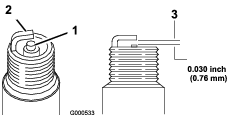
Installing the Spark Plugs
-
Install the spark plugs and metal washers.
-
Tighten the spark plugs to 24.4 to 29.8 N∙m (18 to 22 ft-lb).
-
Push the wires onto the spark plugs (Figure 44).
-
Close and latch the seat.
Fuel System Maintenance
Replacing the Fuel Filter
| Maintenance Service Interval | Maintenance Procedure |
|---|---|
| Every 100 hours |
|
| Every 400 hours |
|
-
Set the parking brake, stop the pump, shut off the engine, and remove the ignition key.
-
Release the latch on the back of the seat and lift the seat forward.
-
Clamp off the hose on either side of the fuel filter to prevent gas from pouring out of the hoses when you remove the filter.
-
Place a drain pan under the filter.
-
Squeeze the ends of the hose clamps together and slide them away from the filter (Figure 46).
-
Remove the filter from the fuel lines.
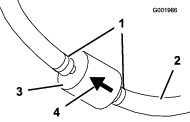
-
Install a new filter and move the hose clamps close to the filter.
Ensure that the flow-direction arrow points toward the engine.
Servicing the Carbon Canister
Checking the Air Filter for the Carbon Canister
| Maintenance Service Interval | Maintenance Procedure |
|---|---|
| After the first 50 hours |
|
| Every 200 hours |
|
Check the opening at the bottom of the air filter for the carbon canister to ensure that it is clean and free of debris and obstructions (Figure 47).
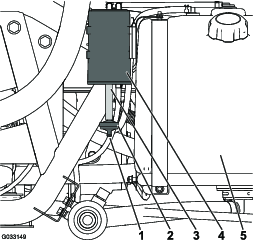
Replacing the Carbon-Canister Filter
| Maintenance Service Interval | Maintenance Procedure |
|---|---|
| After the first 50 hours |
|
| Every 200 hours |
|
-
Remove the barbed fitting of the carbon-canister filter from the hose at the bottom of the carbon canister, and remove the filter (Figure 47).
Note: Discard the old filter.
-
Fully insert the barbed fitting of the new carbon-canister filter into the hose at the bottom of the carbon canister.
Draining the Fuel Tank
| Maintenance Service Interval | Maintenance Procedure |
|---|---|
| Every 400 hours |
|
Drain and clean the fuel tank if the fuel system becomes contaminated or if you plan to store the machine for an extended period. Use fresh, clean fuel to flush out the tank.
-
Transfer the fuel from the tank into an approved fuel container using a siphon pump, or remove the tank from the machine and pour the fuel out of the tank fill spout into the fuel container.
Note: If you remove the fuel tank, also remove the fuel and return hoses from the tank before removing the tank.
-
Replace the fuel filter; refer to Replacing the Fuel Filter.
-
Flush the tank with fresh, clean fuel, if necessary.
-
Install the tank if you removed it.
-
Fill the tank with fresh, clean fuel.
Electrical System Maintenance
Electrical System Safety
-
Disconnect the battery before repairing the machine. Disconnect the negative terminal first and the positive last. Connect the positive terminal first and the negative last.
-
Charge the battery in an open, well-ventilated area, away from sparks and flames. Unplug the charger before connecting or disconnecting the battery.
-
Wear protective clothing and use insulated tools.
Locating the Fuses
There are 2 fuse blocks and 1 empty slot in the electrical system. They are located beneath the seat (Figure 48).
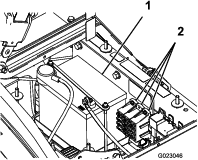
Servicing the Battery
Important: Do not jump start the battery of the machine.
Always keep the battery clean and fully charged. Use a paper towel to clean the battery and battery box. If the battery terminals are corroded, clean them with a solution of 4 parts water and 1 part baking soda. Apply a light coating of grease to the battery terminals to prevent corrosion.
Voltage: 12 V with 280 cold cranking A at 0°F
Removing the Battery
-
Position the sprayer on a level surface, engage the parking brake, shut off the sprayer pump, shut off the engine, and remove the key.
-
The battery is located on the right side of the machine behind the pump (Figure 48).
-
Disconnect the negative (black) ground cable from the battery post.
Warning
Incorrect battery cable routing could damage the sprayer and cables causing sparks. Sparks can cause the battery gasses to explode, resulting in personal injury.
-
Always disconnect the negative (black) battery cable before disconnecting the positive (red) cable.
-
Always connect the positive (red) battery cable before connecting the negative (black) cable.
Warning
Battery terminals or metal tools could short against metal sprayer components causing sparks. Sparks can cause the battery gasses to explode, resulting in personal injury.
-
When removing or installing the battery, do not allow the battery terminals to touch any metal parts of the sprayer.
-
Do not allow metal tools to short between the battery terminals and metal parts of the sprayer.
-
Always keep the battery strap in place to protect and secure the battery.
-
-
Disconnect the positive (red) cable from the battery post.
-
Remove the battery retainer and fasteners (Figure 48).
-
Remove the battery.
Installing the Battery
| Maintenance Service Interval | Maintenance Procedure |
|---|---|
| Every 50 hours |
|
-
Set the battery on the battery box so that the battery posts are toward the front of the sprayer.
-
Install the battery retainer and secure it with the fasteners you removed previously (Figure 48).
Important: Always keep the battery retainer in place to protect and secure the battery.
-
Connect the positive (red) cable to the positive (+) battery post and the negative (black) cable to the negative (-) battery post using the bolts and wing nuts. Slide the rubber boot over the positive battery post.
-
Install the battery cover and secure it with the 2 knobs (Figure 48).
Checking the Electrolyte Level
| Maintenance Service Interval | Maintenance Procedure |
|---|---|
| Every 50 hours |
|
Note: When the machine is in storage check the battery-electrolyte level every 30 days.
-
Loosen the knobs on the sides of the battery box and remove the battery cover (Figure 48).
-
Remove the filler caps. If the electrolyte is not up to the fill line, add the required amount of distilled water; refer to Adding Water to the Battery.
Danger
Battery electrolyte contains sulfuric acid which is a deadly poison and causes severe burns.
-
Do not drink electrolyte or allow it to contact your skin, eyes or clothing. Wear safety glasses to shield your eyes and rubber gloves to protect your hands.
-
Fill the battery where clean water is always available for flushing the skin.
-
Adding Water to the Battery
The best time to add distilled water to the battery is just before you operate the machine. This lets the water mix thoroughly with the electrolyte solution.
-
Clean the top of the battery with a paper towel.
-
Remove the filler caps from the battery and slowly fill each cell with distilled water until the level is up to the fill line. Replace the filler caps.
Important: Do not overfill the battery. Electrolyte will overflow onto other parts of the sprayer and severe corrosion and deterioration will result.
Charging the Battery
Warning
Charging the battery produces gasses that can explode.
Never smoke near the battery and keep sparks and flames away from battery.
Important: Always keep the battery fully charged (1.260 specific gravity). This is especially important to prevent battery damage when the temperature is below 0°C (32°F).
-
Remove the battery from the chassis; refer to Removing the Battery.
-
Check the electrolyte level; refer to Checking the Electrolyte Level.
-
Connect a 3 to 4 A battery charger to the battery posts. Charge the battery at a rate of 3 to 4 A for 4 to 8 hours (12 V).
Important: Do not overcharge the battery.
-
Install the battery in the chassis; refer to Installing the Battery.
Storing the Battery
If the machine will be stored for more than 30 days, remove the battery and charge it fully. Either store it on the shelf or on the machine. Leave the cables disconnected if it is stored on the machine. Store the battery in a cool atmosphere to avoid quick deterioration of the charge in the battery. To prevent the battery from freezing, ensure that it is fully charged.
Drive System Maintenance
Inspecting the Wheels and Tires
| Maintenance Service Interval | Maintenance Procedure |
|---|---|
| After the first 8 hours |
|
| Before each use or daily |
|
| Every 100 hours |
|
Check the tire pressure every 8 hours or daily to ensure proper levels. Fill the tires to 138 kPa (20 psi). Also, check the tires for wear or damage.
Check the wheels to ensure that they are mounted securely after the first 8 operating hours and then every 100 hours thereafter. Torque the front and rear lug nuts to 102 to 108 N∙m (75 to 80 ft-lb).
Check the tire condition at least every 100 hours of operation. Operating accidents, such as hitting curbs, can damage a tire or rim and also disrupt wheel alignment, so inspect the tire condition after an accident.
Adjusting the Differential-Lock Cable
| Maintenance Service Interval | Maintenance Procedure |
|---|---|
| Every 200 hours |
|
-
Move the differential-lock lever to the OFF position.
-
Loosen the jam nuts securing the differential-lock cable to the bracket on the transaxle (Figure 49).
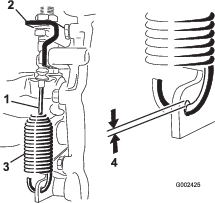
-
Adjust the jam nuts to obtain a 0.25 to 1.5 mm (0.01 to 0.06 inch) gap between the spring hook and the outside diameter of the hole in the transaxle lever.
-
Tighten the jam nuts when finished.
Adjusting the Front Wheel Toe-in
| Maintenance Service Interval | Maintenance Procedure |
|---|---|
| Every 100 hours |
|
The toe-in should be 0 to 6 mm (0 to 1/4 inch).
-
Fill the tank with approximately 331 L (87.5 US gallons) of water.
-
Check and fill all tires; refer to Checking the Air Pressure in the Tire.
-
Drive the sprayer back and forth a few times to relax the A-arms, then drive it forward at least 3 m (10 ft).
-
Measure the distance between both of the front tires at the axle height at both the front and rear of the front tires (Figure 50).
Note: You will need a fixture or alignment gauge for measuring the rear of the front tires at axle height. Use the same fixture or alignment gauge to accurately measure the front of the front tires at axle height (Figure 50).
The front of the tires should be 0 to 6 mm (0 to 1/4 inch) closer than the back side of the front tires.
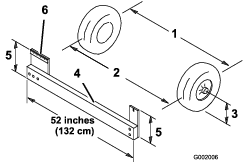
-
If the measurement does not fall within the specified range, loosen the jam nuts at both ends of the tie rods (Figure 51).

-
Rotate both tie rods to move the front of the tire inward or outward.
Note: The tie rods measure the same length.
-
Tighten the tie rod jam nuts when the adjustment is correct.
-
Ensure that there is full travel of the steering wheel in both directions.
Brake Maintenance
Checking the Brake Fluid
The brake-fluid reservoir is shipped from the factory filled with DOT 3 brake fluid. Check the level before starting the engine each day.

-
Position the sprayer on a level surface, set the parking brake, stop the pump, shut off the engine, and remove the ignition key.
-
The fluid level should be up to the FULL line on the reservoir.
-
If the fluid level is low, clean the area around the reservoir cap, remove the cap, and fill the reservoir to the proper level. Do not overfill.
Inspecting the Brakes
| Maintenance Service Interval | Maintenance Procedure |
|---|---|
| Every 100 hours |
|
The brakes are a critical safety component of the sprayer. Inspect them as follows:
-
Inspect the brake shoes for wear or damage. If the lining (brake pad) thickness is less than 1.6 mm (1/16 inch), replace the brake shoes.
-
Inspect the backing plate and other components for signs of excessive wear or deformation. If any deformation is found, replace the appropriate components.
Adjusting the Parking Brake
| Maintenance Service Interval | Maintenance Procedure |
|---|---|
| Every 200 hours |
|
-
Remove the plastic grip.
-
Loosen the set screw securing the knob to the parking-brake lever (Figure 53).

-
Rotate the knob until a force of 18 to 23 kg (40 to 50 lb) is required to actuate lever.
-
Tighten the set screw.
Hydraulic System Maintenance
Hydraulic System Safety
-
Seek immediate medical attention if fluid is injected into skin. Injected fluid must be surgically removed within a few hours by a doctor.
-
Safely relieve all pressure in the hydraulic system before performing any work on it.
-
Ensure that all hydraulic-fluid hoses and lines are in good condition and all hydraulic connections and fittings are tight before applying pressure to the hydraulic system.
-
Keep your body and hands away from pinhole leaks or nozzles that eject high-pressure hydraulic fluid.
-
Use cardboard or paper to find hydraulic leaks.
Hydraulic Fluid Specification
Fluid type: Dexron III ATF.
Reservoir capacity: approximately 7 L (7.5 US qt)
Checking the Transaxle/Hydraulic Fluid
| Maintenance Service Interval | Maintenance Procedure |
|---|---|
| Every 200 hours |
|
-
Position the sprayer on a level surface, engage the parking brake, shut off the sprayer pump, shut off the engine, and remove the key.
-
Remove the transaxle dipstick and wipe it with a clean rag (Figure 54).
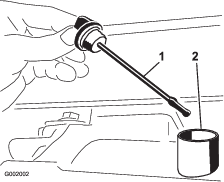
Important: Be very careful not to get dirt or other contaminants into the opening when checking the transmission oil.
-
Insert the dipstick into the tube and make sure that it is seated fully. Remove the dipstick and check the oil level.
-
The transaxle fluid level should be at the top of the flat portion of the dipstick. If it is not, fill the reservoir with the specified hydraulic fluid; refer to Hydraulic Fluid Specification.
-
Install the dipstick firmly in place.
Changing Transaxle/Hydraulic Fluid
| Maintenance Service Interval | Maintenance Procedure |
|---|---|
| Every 800 hours |
|
-
Position the sprayer on a level surface, set the parking brake, stop the pump, shut off the engine, and remove the ignition key.
-
Place a drain pan under the drain plug of the reservoir.
-
Remove the drain plug from the side of the reservoir, and let the hydraulic fluid flow into the drain pan (Figure 55).
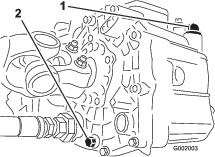
-
Note the orientation of the hydraulic hose and 90° fitting connected to the strainer.
-
Remove the hydraulic hose and 90° fitting (Figure 56).
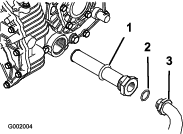
-
Remove the strainer and clean it by back flushing it with a clean degreaser.
-
Allow the strainer to air dry.
-
Install the strainer when the oil is draining.
-
Install the hydraulic hose and 90° fitting to the strainer.
-
Install and tighten the drain plug.
-
Fill the reservoir with approximately 7 L (7.5 US qt) of Dexron III ATF.
Important: Use only the hydraulic fluids specified. Other fluids could cause system damage.
-
Start the engine and drive the sprayer to fill the hydraulic system.
-
Check the oil level and replenish it, if required.
Replacing the Hydraulic Filter
| Maintenance Service Interval | Maintenance Procedure |
|---|---|
| After the first 8 hours |
|
| Every 800 hours |
|
Use the Toro replacement filter (Part No. 54-0110).
Important: Use of any other filter may void the warranty on some components.
-
Position the sprayer on a level surface, set the parking brake, stop the pump, shut off the engine, and remove the ignition key.
-
Clean the area around the filter mounting area.
-
Place a drain pan under the filter.
-
Remove the filter (Figure 57).

-
Lubricate the new filter gasket.
-
Ensure that the filter mounting area is clean.
-
Screw the filter on until the gasket contacts the mounting plate, then tighten the filter 1/2 turn.
-
Start the engine and let it run for about 2 minutes to purge air from the system.
-
Shut off the engine and check the hydraulic-fluid level and for leaks; refer to Checking the Transaxle/Hydraulic Fluid.
Checking the Hydraulic Lines and Hoses
Inspect the hydraulic lines and hoses daily for leaks, kinked lines, loose mounting supports, wear, loose fittings, weather deterioration, and chemical deterioration. Make all necessary repairs before operating.
Spray System Maintenance
Inspecting the Hoses
| Maintenance Service Interval | Maintenance Procedure |
|---|---|
| Every 200 hours |
|
Examine each hose in the spray system for cracks, leaks or other damage. At the same time, inspect the connections and fittings for similar damage. Replace any worn or damaged hoses and fittings.
Changing the Suction Filter
| Maintenance Service Interval | Maintenance Procedure |
|---|---|
| Every 400 hours |
|
Note: Determine the appropriate suction filter mesh size that you need for your job; refer to Selecting a Suction Filter.
-
Park the machine on a level surface, engage the parking brake, shut off the pump, shut off the engine, and remove the key.
-
At the top of the sprayer tank, remove the retainer that secures the hose fitting attached to the large hose from the filter housing (Figure 58).

-
Remove the hose and hose fitting from the filter housing (Figure 58).
-
Remove the old suction filter from the filter housing in the tank (Figure 59).
Note: Discard the old filter.

-
Install the new suction filter into the filter housing.
Note: Ensure that the filter is fully seated.
-
Align the hose and hose fitting to the filter housing at the top of the tank, and secure the fitting and housing with the retainer that you removed in step 2.
Changing the Pressure Filter
| Maintenance Service Interval | Maintenance Procedure |
|---|---|
| Every 400 hours |
|
-
Move the machine to a level surface, shut off the sprayer pump, shut off the engine, and remove the key.
-
Align a drain pan under the pressure filter (Figure 60).

-
Rotate the drain plug counterclockwise and remove it from the bowl of the pressure filter (Figure 60).
Note: Allow the bowl to drain completely.
-
Rotate the bowl counterclockwise and remove from its filter head (Figure 60).
-
Remove the old pressure filter element (Figure 60).
Note: Discard the old filter.
-
Check the O-ring for the drain plug (located inside the bowl) and the O-ring for bowl (located inside the filter head) for damage and wear (Figure 60).
Note: Replace any damaged or worn O-rings for the plug, bowl, or both.
-
Install the new pressure filter element into the filter head (Figure 60).
Note: Ensure that the filter element is firmly seated into the filter head.
-
Install the bowl onto the filter head and tighten by hand (Figure 60).
-
Install the plug into the bowl and tighten by hand (Figure 60).
Changing the Nozzle Filter
Note: Determine the appropriate nozzle filter mesh size that you need for your job; refer to Selecting a Nozzle-Tip Filter (Optional).
-
Park the machine on a level surface, engage the parking brake, shut off the sprayer pump, shut off the engine, and remove the key.
-
Remove the nozzle from the spray turret (Figure 61).

-
Remove the old nozzle filter (Figure 61).
Note: Discard the old filter.
-
Install the new nozzle filter (Figure 61).
Note: Ensure that the filter is fully seated.
-
Install the nozzle onto the spray turret (Figure 61).
Inspecting the Pump
| Maintenance Service Interval | Maintenance Procedure |
|---|---|
| Every 400 hours |
|
Note: The following machine components are considered parts subject to consumption through use unless found defective and are not covered by the warranty associated with this machine.
Have an authorized Toro distributor check following internal pump components for damage:
-
Pump diaphragms
-
Pump check valves assemblies
Replace any components, if necessary.
Inspecting the Nylon Pivot Bushings
| Maintenance Service Interval | Maintenance Procedure |
|---|---|
| Every 400 hours |
|
-
Park the machine on a level surface, engage the parking brake, shut off the pump, shut off the engine, and remove the key.
-
Extend the outer-boom sections to the spray position and support the booms using stands or straps and lifting equipment.
-
With the weight of the boom supported, remove the bolt and nut securing the pivot pin to the boom assembly (Figure 62).
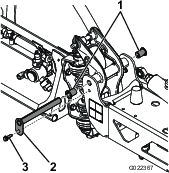
-
Remove the bolt and nut that secure the pivot pin, and remove the pin (Figure 62).
-
Remove the boom and pivot bracket assembly from the center frame to access the nylon bushings.
-
Remove and inspect the nylon bushings from the front and back sides of the pivot bracket (Figure 62).
Note: Replace any worn or damaged bushings.
-
Place a small amount of oil on the nylon bushings, and install them into pivot bracket (Figure 62).
-
Install the boom and pivot bracket assembly into the center frame, aligning the holes (Figure 62).
-
Install the pivot pin and secure it with the bolt and nut removed in step 4.
-
Repeat steps 2 through 9 for the other outer-boom section.
Adjusting the Booms to Level
Use the following procedure to adjust the level of the left and right booms sections when they are in the spray position.
-
Extend the booms to the spray position.
-
Remove the cotter pin from the pivot pin (Figure 63).
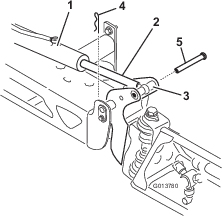
-
Lift up on the boom and remove the pin (Figure 63), and slowly lower the boom to the ground.
-
Inspect the pin for any damage and replace it if necessary.
-
Use a wrench on the flat sides of the actuator rod to immobilize it, then loosen the jam nut to allow the eyelet rod to be adjusted (Figure 64).

-
Turn the eyelet rod in the actuator rod to shorten or lengthen the extended actuator to the desired position (Figure 64).
Note: You must turn the eyelet rod in half or complete revolutions so that you can assemble the rod to the boom.
-
Once the desired position has been achieved, tighten the jam nut to secure the actuator and eyelet rod.
-
Raise the boom to align the pivot with the actuator rod.
-
While holding the boom, insert the pin through both boom pivot and actuator rod (Figure 63).
-
With the pin in place, release the boom and secure the pin with the cotter previously removed.
-
Repeat the procedure for each actuator rod bearing, if necessary.
Cleaning
Cleaning the Flow Meter
| Maintenance Service Interval | Maintenance Procedure |
|---|---|
| Every 200 hours |
|
-
Thoroughly rinse and drain the entire spraying system.
-
Remove the flow meter from the sprayer and flush it with clean water.
-
Remove the retainer ring on the upstream side (Figure 65).
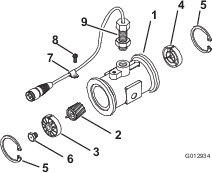
-
Clean the turbine and the turbine hub to remove metal filings and any wettable powders.
-
Inspect the turbine blades for wear.
Note: Hold the turbine in your hand and spin it. It should spin freely with very little drag. If it does not, replace it.
-
Assemble the flow meter.
-
Use a low pressure (50 kPa or 5 psi) air jet to ensure that the turbine spins freely.
Note: If the turbine does not spin freely, loosen the hex stud on the bottom of the turbine hub by 1/16 of a turn until it does spins freely.
Cleaning the Sprayer Valves
-
To clean the rate-control valve, refer to the following sections:
-
To clean the agitation valve; refer to the following sections:
-
To clean the master-section valve, refer to the following sections:
-
To clean the 3 section valves; refer to the following sections:
Removing the Valve Actuator
-
Position the sprayer on a level surface, engage the parking brake, shut off the pump, shut off the engine, and remove the key.
-
Remove the 3-pin connector of the valve actuator from the 3-socket connector of the sprayer harness.
-
Remove the retainer that secures the actuator to the manifold valve for the rate control, agitation, master section, or section valve (Figure 66).
Note: Squeeze the 2 legs of the retainer together while pushing it down.
Note: Retain the actuator and retainer for installation in Installing the Valve Actuator.
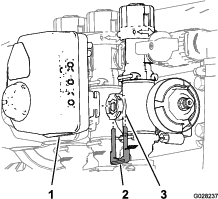
-
Remove the actuator from the manifold valve.
Removing the Rate-Control-Manifold Valve
-
Remove the clamps and gaskets that secure the manifold for the rate-control valve (Figure 67).
Note: Retain the clamp(s) and gasket(s) for installation in Installing the Rate Control Manifold Valve.
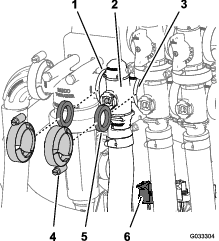
-
Remove the retainer that secures the outlet fitting to the manifold for the rate-control valve (Figure 68).

-
Remove the 2 flanged-head bolts and 2 flanged locknuts that secure the rate-control valve to the valve mount and remove the valve manifold from the machine (Figure 68).
Note: If necessary, loosened the mounting hardware for the pressure-filter head to ease removal of the rate-control valve.
Removing the Agitation-Manifold Valve
-
Remove the clamps and gaskets that secure the manifold for the agitation valve (Figure 69) to the agitation-bypass valve, rate-control valve, master-section valve, and adapter fitting (agitation-throttle valve).
Note: Retain the clamp(s) and gasket(s) for installation in Installing the Agitation-Manifold Valve.
-
Remove the retainer that secures the outlet fitting to the manifold for the agitation valve (Figure 69).
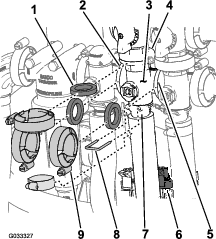
-
Remove the flanged-head bolt and flanged locknut that secures the agitation valve to the valve mount and remove the valve manifold from the machine (Figure 70).
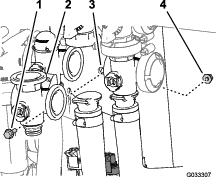
Removing the Master-Section-Manifold Valve
-
Remove the clamps and gaskets that secure the manifold for the master-section valve (Figure 71) to the master-section-bypass valve, agitation valve, and master-section-manifold valve (at the end of the hose for the flow meter).
Note: Retain the clamp(s) and gasket(s) for installation in Installing the Master-Section-Manifold Valve.
-
Remove the retainer that secures the outlet fitting to the manifold for the master-section valve (Figure 71).

-
Remove the flanged-head bolt and flanged locknut that secures the master-section valve to the valve mount and remove the valve manifold from the machine (Figure 72).
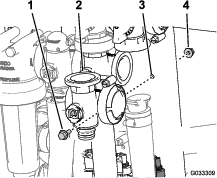
Removing the Section-Manifold Valve
-
Remove clamps and gaskets that secure the manifold for the section valve (Figure 73) to the adjacent section valve (if left section valve, and the reducer coupling).
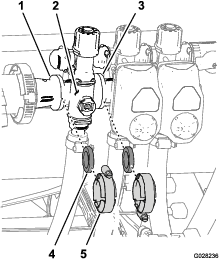
-
Remove the retainers that secure the outlet fitting to the section-valve manifold and the valve manifold to the bypass fitting (Figure 74).
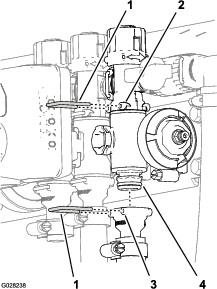
-
For the left or right section valves, remove the flanged-head bolts and flanged locknuts that secure the section valve(s) to the valve mount and remove the valve manifold(s) from the machine; for the center section valve, remove the section-valve manifold from the machine (Figure 75).

Cleaning the Manifold Valve
-
Position the valve stem so that it is in the closed position (Figure 76B).

-
Remove the 2 end-cap-fitting assemblies from each end of the manifold body (Figure 77 and Figure 78).
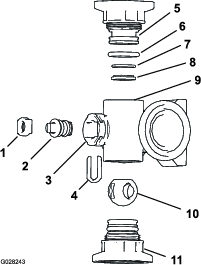

-
Turn the valve stem so that the ball is in the open position (Figure 76A).
Note: When the valve stem is parallel with the valve flow, the ball slides out.
-
Remove the stem retainer from the slots in the stem port in the manifold (Figure 77 and Figure 78).
-
Remove the stem retainer and valve stem seat from the manifold (Figure 77 and Figure 78).
-
Reach into the manifold body and remove the valve-stem assembly (Figure 77 and Figure 78).
-
Clean the inside of the manifold and exterior of the ball valve, valve-stem assembly, stem capture, and end fittings.
Assembling the Manifold Valve
Operator supplied material: Clear silicone grease.
Important: Use only silicone grease when assembling the valve.
-
Check the condition of the outlet fitting O-rings (section valve manifold only), end cap O-rings, back seating O-rings, and ball seat for damage or wear (Figure 77 and Figure 78).
Note: Replace any damaged or worn O-rings or seats.
-
Apply silicone grease to the valve stem and insert it into the valve stem seat (Figure 77 and Figure 78).
-
Install the valve stem and seat into the manifold and secure the stem and seat with the stem retainer (Figure 77 and Figure 78).
-
Ensure that the back seating O-ring and the ball seat are aligned and seated into the end-cap fitting (Figure 77 and Figure 78)
-
Install the end-cap fitting assembly onto the manifold body until the flange of the end-cap fitting touches the manifold body (Figure 77 and Figure 78), then turn the end-cap fitting an additional 1/8 to 1/4 turn.
Note: Use caution so as not to damage the end of the fitting.
-
Insert the ball into the valve body (Figure 79).
Note: The valve stem should fit inside the ball drive slot. If the valve stem does not fit, adjust the position of the ball (Figure 79).
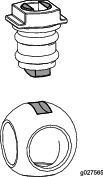
-
Turn the valve stem assembly so that the valve is closed (Figure 76B)
-
Repeat steps 4 and 5 for the other end-cap fitting assembly.
Installing the Rate Control Manifold Valve
-
Align a gasket between the flanges of the rate control valve manifold and the pressure filter head (Figure 80A).
Note: If needed, loosen the mounting hardware for the pressure filter head as needed to provide clearance.
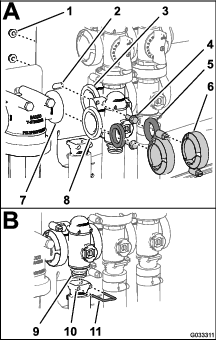
-
Assemble the rate control valve manifold, gasket, and pressure filter head with a flange clamp and tighten by hand (Figure 80A).
-
Align a gasket between the flanges of the rate control valve and the agitation-valve manifold (Figure 80A).
-
Assemble the rate control valve manifold, gasket, and agitation-valve manifold with a flange clamp and tighten by hand (Figure 80A).
-
Assemble the rate control valve to the valve mount with the 2 flanged-head bolts and 2 flanged locknuts (Figure 80A) that you removed in step 3 of Removing the Rate-Control-Manifold Valve and torque the nut and bolt to 10 to 12 N∙m (90 to 110 in-lb).
-
Assemble the outlet fitting onto the coupling fitting at the bottom of the manifold for the rate control valve (Figure 80B).
-
Secure the outlet fitting coupling fitting by inserting a retainer into the socket of the outlet fitting (Figure 80B).
-
If you loosened the mounting hardware for the pressure filter head, tighten the nut and bolt to 10 to 12 N∙m (90 to 110 in-lb).
Installing the Agitation-Manifold Valve
-
Align the flange of the agitation-valve manifold, 1 gasket, and the flange of the agitation-bypass valve (Figure 81A).
Note: If needed, loosen the mounting hardware for the master-section valve as needed to provide clearance.
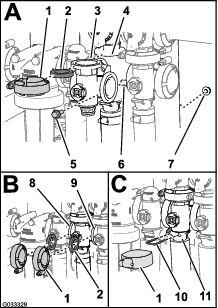
-
Assemble the agitation-bypass valve, gasket, and agitation-valve manifold with a clamp tightened by hand (Figure 81A).
-
Align a gasket between the flanges of the rate-control valve and the agitation-valve manifold (Figure 81B).
-
Assemble the gasket and agitation-valve manifold with a clamp tightened by hand (Figure 81B).
-
Align a gasket between the flanges of the agitation-valve manifold and the master-section valve (Figure 81B).
-
Assemble the agitation-valve manifold, gasket, and master-section valve with a clamp tightened by hand (Figure 81B).
-
Assemble the agitation-valve manifold and socket with a clamp tightened by hand (Figure 81C).
-
Secure the end-cap fitting to the outlet fitting by inserting a retainer into the socket of the outlet fitting (Figure 81C).
-
Assemble the agitation valve to the valve mount with the flanged-head bolt and flanged locknut that you removed in step 3 of Removing the Agitation-Manifold Valve and torque the nut and bolt to 1017 to 1243 N∙cm (90 to 110 in-lb).
-
If you loosened the mounting hardware for the master-section valve, tighten the nut and bolt to 1978 to 2542 N∙cm (175 to 225 in-lb).
Installing the Master-Section-Manifold Valve
-
Align the flange of the master-section-valve manifold, 1 gasket, and the flange of the master-section-bypass valve (Figure 82A).
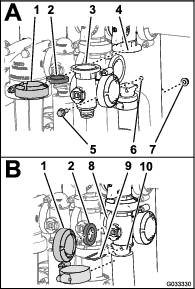
-
Assemble the master-section-valve manifold, gasket, and master-section-bypass valve with a clamp tightened by hand (Figure 82A).
-
Align the flange of the master-section-valve manifold, a gasket, and the agitation-valve manifold (Figure 82B).
-
Assemble the master-section-valve manifold, gasket, and agitation-valve manifold with a clamp tightened by hand (Figure 82B)
-
Align the flange of the master-section-valve manifold, a gasket, and the master-section house (Figure 82B).
-
Assemble the master-section-valve manifold and socket with a clamp tightened by hand (Figure 82B).
-
Secure the end-cap fitting to the outlet fitting by inserting a retainer into the outlet fitting (Figure 82B).
-
Assemble the agitation valve to the valve mount with the flanged-head bolt and flanged locknut that you removed in step 3 of Removing the Master-Section-Manifold Valve and torque the nut and bolt to 1017 to 1243 N∙cm (90 to 110 in-lb).
Installing the Section Manifold Valve
-
Insert the upper end-cap fitting of the manifold valve into the bypass fitting (Figure 83A).
Note: If needed, loosen the mounting hardware for the bypass fitting to provide clearance.
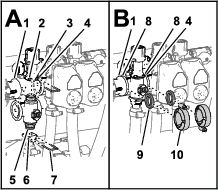
-
Secure the end-cap fitting to the bypass fitting by inserting a retainer into the socket of the bypass fitting (Figure 83A).
-
Assemble the outlet fitting onto the lower end-cap fitting of the manifold valve (Figure 83A).
-
Secure the end-cap fitting to the outlet fitting by inserting a retainer into the socket of the outlet fitting (Figure 83A).
-
Align a gasket between the flanges of the reducer coupling and the section valve manifold (Figure 83B).
-
Assemble the reducer coupling, gasket, and section valve manifold with a clamp and tighten by hand (Figure 83B).
-
If installing the 2 left most section valves, align a gasket between the flanges of the 2 adjacent section valve manifolds (Figure 83B).
-
Assemble the 2 adjacent section valve manifolds and gasket with a clamp and tighten by hand (Figure 83B).
-
For the left or right boom section valves, assemble the valves to the valve mount with the flanged-head bolt and flanged locknut that you removed in step 3 of Removing the Section-Manifold Valve and torque the nuts and bolts to 10 to 12 N∙m (90 to 110 in-lb).
-
If you loosened the mounting hardware for the bypass fitting, tighten the nut and bolt to 10 to 12 N∙m (90 to 110 in-lb).
Installing the Valve Actuator
-
Align the actuator to the manifold valve and (Figure 66).
-
Secure the actuator and valve with the retainer that you removed in step 3 of Removing the Valve Actuator.
-
Connect the 3-pin connector of the valve-actuator harness to the 3-socket connector of the wire harness of the sprayer.
Storage
Preparing the Sprayer System
-
Position the sprayer on a level surface, engage the parking brake, shut off the pump, shut off the engine, and remove the key.
-
Clean dirt and grime from the entire machine, including the outside of the engine cylinder head fins and blower housing.
Important: You can wash the machine with mild detergent and water. Do not use high-pressure water to wash the machine. Pressure washing may damage the electrical system or wash away necessary grease at friction points. Avoid excessive use of water, especially near the control panel, lights, engine, and the battery.
-
Clean the spray system; refer to .
-
Clean the ball valve in the valve assembly; refer to Cleaning the Manifold Valve.
-
Condition the sprayer system as follows:
-
Drain the fresh-water tank.
-
Drain the spray system as completely as possible.
-
Prepare rust inhibiting, non-alcohol based, RV antifreeze solution per the manufacturer's instructions.
-
Add the RV antifreeze solution to the fresh-water tank, the sprayer tank, and if installed the optional rinse tank.
-
If installed, pump the RV antifreeze solution in the optional rinse tank into the spray tank.
-
Run the sprayer pump for a few minutes to circulate the RV antifreeze throughout the sprayer system and any installed spray accessories.
Spray the RV antifreeze solution out of the spray nozzles.
-
Drain the fresh-water tank and spray system as completely as possible.
-
-
Use the boom-section lift switches to raise the outer-boom sections. Raise the sections until they have moved completely into the boom-transport cradle, forming the ‘X’ transport position and the section cylinders are fully retracted.
Note: Make sure that the section cylinders are fully retracted to prevent actuator rod damage.
Performing the Service Procedures
-
Inspect the brakes; refer to Inspecting the Brakes.
-
Service the air cleaner; refer to Servicing the Air Cleaner.
-
Grease the sprayer; refer to the Lubrication.
-
Change the crankcase oil; refer to Changing the Engine Oil.
-
Check the air pressure in the tires; refer to Checking the Air Pressure in the Tire.
Preparing the Engine and Battery
-
For storage over 30 days, prepare the fuel system as follows:
-
Add a petroleum based stabilizer/conditioner to fuel in the tank.
Follow mixing instructions from stabilizer manufacturer. Do not use an alcohol based stabilizer (ethanol or methanol).
Note: A fuel stabilizer/conditioner is most effective when mixed with fresh gasoline and used at all times.
-
Run the engine to distribute conditioned fuel through the fuel system (5 minutes).
-
Shut off the engine, allow it to cool, and drain the fuel tank.
-
Start the engine and run it until it stops.
-
Choke the engine.
-
Start and run the engine until it does not start again.
-
Dispose of fuel properly. Recycle as per local codes.
Important: Do not store stabilizer/conditioned fuel over 90 days.
-
-
Remove the spark plugs and check their condition; refer to Removing the Spark Plugs.
-
With the spark plugs removed from the engine, pour 2 tablespoons of engine oil into the spark plug hole.
-
Use the electric starter to crank the engine and distribute the oil inside the cylinder.
-
Install the spark plugs and tighten to recommended torque; refer to Installing the Spark Plugs.
Note: Do not install the wire on the spark plug(s).
-
Remove the battery from the chassis, check the electrolyte level, and charge it fully; refer to Removing the Battery.
Note: Do not connect the battery cables to the battery posts during storage.
Important: The battery must be fully charged to prevent it from freezing and being damaged at temperatures below 0°C (32°F). A fully charged battery maintains its charge for about 50 days at temperatures lower than 4°C (40°F). If the temperatures will be above 4°C (40°F), check the water level in the battery and charge it every 30 days.
Preparing the Machine
-
Check and tighten all bolts, nuts, and screws. Repair or replace any part that is damaged.
-
Check the condition of all spray hoses, replacing any that are damaged or worn.
-
Tighten all hose fittings.
-
Paint all scratched or bare metal surfaces. Paint is available from your authorized Toro distributor.
-
Store the machine in a clean, dry garage or storage area.
-
Remove the ignition key and put it in a safe place out of the reach of children.
-
Cover the machine to protect it and keep it clean.
Troubleshooting
| Problem | Possible Cause | Corrective Action |
|---|---|---|
| The starter does not crank. |
|
|
| The engine cranks but does not start. |
|
|
| The engine starts but does not keep running. |
|
|
| The engine runs but knocks or misses. |
|
|
| The engine does not idle. |
|
|
| The engine overheats. |
|
|
| The engine loses power. |
|
|
| There is abnormal vibration or noise. |
|
|
| The machine does not operate or is sluggish in either direction because the engine bogs down or stalls. |
|
|
| The machine does not operate in either direction. |
|
|
| Problem | Possible Cause | Corrective Action |
|---|---|---|
| A section does not spray. |
|
|
| A section does not turn off. |
|
|
| A section valve is leaking. |
|
|
| The spray nozzle(s) drip when the section switch(es) is shut off |
|
|
| A pressure drop occurs when you turn on a section. |
|
|
Schematics
Sprayer System Schematic
